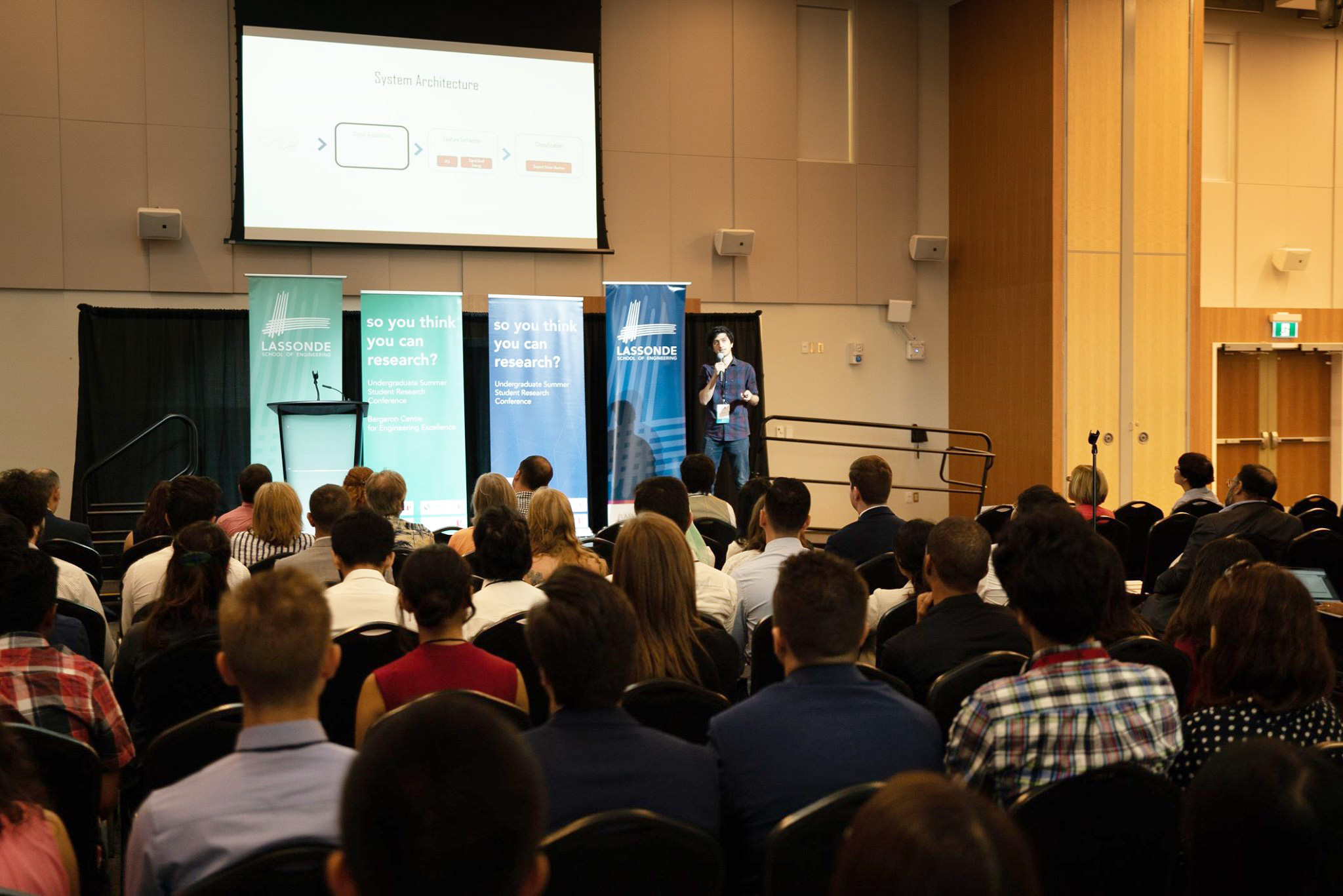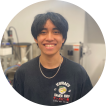
Lassonde Undergraduate Summer Research Conference 2025 Researchers
Get to know your researchers!
Project Presentations
This year’s research conference includes project presentations of undergraduate students and their research experiences. Read firsthand as these students share their experiences and discuss the various research opportunities available to undergraduates. Explore a variety of topics and subject matter at this year’s conference. Learn about recent discoveries, cutting-edge research, and emerging technologies in fields such as modeling atmospheric scattering on Mars with lasers, Exploring the efficacy of hydrological performance of green roofs, pretreatment optimization for wastewater, deploying AI models in resource-constrained environments
.
Researchers
-
Civil Engineering

Aahab Rasheed
Program: LURA
Supervisor: Satinder Brar
Profile: Aahab is a third-year Civil Engineering student with a strong interest in sustainable technologies. He is passionate about applying scientific research to real-world challenges, particularly in water quality and pollution control. Aahab decided to participate in the summer research program to gain hands-on experience in lab-based research, expand his knowledge of environmental contaminants, and contribute to solutions that improve public and ecological health.
Abstract Title: Integrated Pretreatment Optimization for Wastewater and Sludge Across All Wastewater Treatment Stages Absract
Abstract Authors: Aahab Rasheed, Isabel Joseph, Juviya Mathew, Satinder Kaur Brar
Abstract: Plastics have become an integral component of modern human life, resulting in an annual production of 350 million tons. However, the unregulated and excessive use of plastics has led to their emergence as a global pollutant. A significant concern in this context is "microplastic pollution," which refers to plastics smaller than 5 mm that are present in various environmental matrices in different forms, known as microplastics (MPs). This project aims to develop a qualitative and quantitative method for analyzing MPs in wastewater (WW) samples. The study addresses a critical challenge in environmental monitoring: the accurate extraction and detection of MPs from wastewater (WW) and sludge (WWS) samples. MPs often adhere to organic and inorganic solids, complicating their isolation and quantification using standard techniques. To address this issue, our research evaluated a pretreatment method that combines Fenton oxidation and ultrasonication and is termed Ferro-sonication (Fe-UlS). Samples were collected across all WW treatment stages and subjected to Fe-UlS using 20 mL Fenton reagent, and 31% amplitude for 30 minutes. We assessed changes in total suspended solids (TSS) before and after pretreatment to evaluate the efficacy of the proposed approach. Initial results indicate that Fe-UlS achieved over an 80% reduction in TSS across all treatment stages, signifying substantial degradation of organic particles. This study is the first to apply Fe-UlS across WW and WWS, demonstrating its potential to standardize pretreatment protocols for MP monitoring. The method reduces preparation time, reagent consumption, and safety risks, rendering it suitable for routine analysis and future scaling. These findings contribute to enhanced wastewater analytics and aid in mitigating MP discharge into aquatic environments, thereby advancing the United Nations Sustainable Development Goal 6 on clean water and sanitation.Ahmad Mali
Program: LURA
Supervisor: Satinder Brar
Profile: Ahmad is a Biotechnology student who joined the summer research program to explore the real-world connection between biology and engineering. The project on wastewater treatment aligned with his interests and provided an opportunity to apply his knowledge. With prior lab experience, he was eager to sharpen his techniques, learn new skills, and gain hands-on research experience while also making connections and contributing to environmental solutions.
Abstract Title: Development of a High-Yield EPS Extraction Protocol for Suspended and Attached Growth Sludge Systems
Abstract Authors: Ahmad Mali, Gaurav Bhardwaj, Satinder K. Brar
Abstract: Extracellular polymeric substances (EPS) play a pivotal role in biofilm structure and function, yet their efficient extraction from sludge without inducing cell lysis remains a methodological challenge. The absence of a universally accepted protocol and the risk of EPS disruption during extraction procedures necessitate the development of a standardized, high-yield, and non-destructive method. This study aims to develop a robust EPS extraction protocol tailored for both suspended and attached growth systems. Sludge samples were collected from bench-scale activated sludge (ASP) and moving bed biofilm reactor (MBBR) systems. Soluble and loosely bound (LB-EPS) were sequentially extracted through centrifugation, with supernatants collected for further analysis. For tightly bound EPS (TB-EPS), extraction was performed using control (centrifugation at 5000×g, 20 min, 4 °C), physical, and chemical methods. Physical treatments included heating (80 °C for 10 min), ultrasonication (20 W, 3 min), and freeze–thaw (−80 °C to 30 °C, 3 cycles). Chemical methods involved reagents such as 1 M NaOH (pH 11), 95% H₂SO₄ (pH 3), 2% EDTA, and 36.5% HCHO with 1 M NaOH. All samples were filtered through 0.45 µm membranes and stored at −20 °C. EPS fractions are subjected to biochemical assays to assess yield and composition, enabling evaluation of extraction efficiency and method reproducibility. EPS yields from each method will be compared, and the most promising methods will be statistically optimized using Box-Behnken design under response surface methodology. This ongoing study is expected to provide a reliable, high-yield EPS extraction method with minimal cell disruption, applicable across diverse sludge systems.
Ema Glassford
Program: USRA
Supervisor: Magdalena Krol and Usman Khan
Profile: Ema is a third-year Civil Engineering student working at the Climate-Data-Driven Design (CD3) Facility for Built Infrastructure under the supervision of Dr. Krol and Dr. Khan. Her involvement in the same project earlier in the academic year inspired her to continue her research through Lassonde’s Undergraduate Research Program. She hopes to further deepen her passion in structural, water and environmental engineering by developing new and existing technical skills.
Abstract Title: Exploring the Efficacy of Hydrological Performance of Green Roofs
Abstract Authors: Ema Glassford, Magdalena Krol, Usman T. Khan, Kevin Zhang
Abstract: Green roofs provide social, environmental and infrastructural solutions in urban areas, supporting natural ecosystems, offsetting carbon emissions, and prolonging the life of buildings and stormwater systems. The water retention and detention capabilities of green roofs are especially of interest as they reduce and control the amount of water exiting the roof. The objective of this project is to directly compare the hydrological performance of one green roof and one non green roof with similar membrane and insulation configurations. To do this, the water balance of the roofs will be measured. Two gutters installed on the green roof module capture water from soil infiltration and surface runoff. On the non green roof, a single gutter captures the total runoff discharged from the roof. A weather station at the location of the roofs measures the precipitation, pressure transducers measure the volume of water collected over time from the gutters, and soil moisture sensors measure the water stored in the soil of the plant modules. From the collected data, a comparison of the retention, detention and peak runoff of the roof designs will be performed. Our hypothesis is the green roof will be able to retain and detain water more effectively with the collected volume of water being reduced by 75% and therefore reduce the peak runoff. This will outline the benefit of integrating green roofs in urban areas as it prolongs the life of stormwater systems and reduces the risks of flooding during major rain events. This project also lays the groundwork for future research, namely in exploring the energy performance of green roofs.
Gabriel Viegas Dias
Program: LURA
Supervisor: Kevin Gingerich
Profile: Gabriel is a fourth-year Civil Engineering student at Lassonde. After learning about the opportunity to do research focused on his transportation interests, Gabriel applied for the Lassonde Undergraduate Research Award. He is now working on Automated Speed Enforcement in School and Community Safety Zones.
Abstract Title: Assessing Road Safety and Equity of Mobile Automated Speed Enforcement Cameras
Abstract Authors: Gabriel Viegas Dias, Islamiat Azeez, Kevin Gingerich
Abstract: Mobile Automated Speed Enforcement (ASE) cameras are one tool used to enforce speed limits and improve safety on roadways. ASE deployment has become commonplace in Ontario Community Safety Zones and School Zones since 2019 in communities such as Vaughan, Mississauga, Brampton, and Caledon. ASE cameras send photographic evidence with location and time data when excessive speeds are observed for a detected vehicle. Vehicle speeds as high as 200 kph have been recorded and pose a very high risk to public safety. In Ontario, processing centres are used to apply a fine based on the amount of excessive speeding. The number of cameras in each community depends on resources allocated to them by their city council, ranging from 3 cameras in Caledon to 150 cameras in Toronto. Each camera typically detects more than one thousand violations per year. Yet research is required to understand the impacts of ASE on vehicle speeds near cameras before, during, and after deployment, when the camera is moved to another location. In addition, careful attention is needed such that an ASE program does not negatively target key vulnerable demographics. This research supports existing literature by collecting and assessing data pertaining to ASE cameras, vehicle speeds, and traffic volumes. The perceived impact of ASE on marginalized communities is explored through the dissemination of a survey to municipalities collaborating on this study. The results of this work will help municipal engineers and planners coordinate the deployment of ASE cameras to maximize the safety benefits of lower speeds while minimizing the negative targeting of enforcement on vulnerable communities.
Giovanni De Lio
Program: LURA
Supervisor: Kamelia Atefi-Monfared
Profile: Giovanni is a recent graduate of the Civil Engineering program at the Lassonde School of Engineering. Since April of 2023, he has worked as an undergraduate research assistant supervised by Dr. Kamelia Atefi Monfared. During this time, Giovanni has worked on several projects, with a specific interest in modeling geothermal energy extraction. His participation in the LURA program allows him to further develop his computational geomechanics skills for key practical applications.
Abstract Title: Assessing Tunnel Excavation Impact on a Historical Structure in Naples through Advanced Coupled Geomechanical Modeling
Abstract Authors: Kamelia Atefi-Monfared, Giovanni De Lio
Abstract: As the world grows in population and economic activity, extra strain is put on the environment we live in. Specifically, as population grows, so does the demand on infrastructure. Tunnels are used to create transportation systems in both above and below-ground applications (subway systems, mountainous highway construction, underwater roadway construction). Tunnels are also widely used in infrastructure projects to support water supply, sanitary/storm drainage, and electrical/communication utilities. Especially important in underground tunneling beneath pre-existing infrastructure is predicting and limiting ground settlement above the proposed tunnel (which can lead to significant damage to affected structures and infrastructure). Ground settlements can arise from the tunneling excavation process, even more intricate in weak soils and in the presence of water table. Advanced geomechanical modeling is thus critical in predicting such geo-environmental impacts of tunneling excavation to be able to design sustainable tunneling strategies. This research aims to create and validate a finite difference numerical model of an underground bored tunnel in a highly variable soil stratigraphy with the presence of groundwater to assess and predict the effects of the tunnel on a nearby historical structure. The proposed plan is to model a tunnel based in the city of Naples, Italy, and is being carried out in collaboration with the University of Napoli. The model is to be created using a finite difference modeling software, _FLAC 3D_, in conjunction with a complex geometry meshing tool, _Griddle_, by Itasca Software. The modelling will include the use of a groundwater table element in accordance with coupled hydro-mechanical solving operations. Also, in order to accurately simulate the soil-tunnel interaction, the research plan includes the use of detailed interface elements. Finally, to ensure the significance of key input parameters, sensitivity analyses will be carried out.Mariam Jasim
Program: USRA
Supervisor: Satinder Brar
Profile: Mariam is a fourth-year Biology student at York University with a strong interest in scientific inquiry and innovation. She joined the summer research program to expand her academic and technical skillset, engage in critical thinking beyond textbooks, and explore how research contributes to real-world impact. Driven by curiosity and a passion for lifelong learning, she values the opportunity to grow as both a student and a scientist.
Abstract Title: Enhanced Carotenoid Production through Co-culturing of Rhodosporidium toruloides and Chlorella vulgaris
Abstract Authors: Mariam Jasim, Lachi Wankhede, and Satinder Kaur Brar
Abstract: The increasing demand for natural pigments has intensified interest in microbial carotenoids due to their antioxidant properties and potential applications in food, cosmetics, and pharmaceuticals. Among microbial sources, _Rhodosporidium toruloides_, an oleaginous yeast, and _Chlorella vulgaris_, a photosynthetic microalga, are notable producers of carotenoids and lipids. This study explores a novel co-culturing approach to synergistically enhance carotenoid production by enhancing the complementary metabolic capabilities of these two organisms. Co-cultivation was carried out in yeast malt (YM) medium under varying microalgae-to-yeast inoculation ratios (2:1, 1:1, and 3:1), compared against monocultures of each strain. Biomass productivity, total carotenoid content, and lipid accumulation were quantified at the end of the cultivation period. Lipid extracts were further characterized by gas chromatography to determine fatty acid methyl ester (FAME) profiles. The study hypothesize that co-cultures will outperform monocultures in terms of carotenoid and lipid yields due to improved resource utilization, interspecies interactions, and potential exchange of growth-promoting factors. Specifically, _C. vulgaris_ may contribute oxygen and fixed carbon, while _R. toruloides_ may provide vitamins or growth-promoting metabolites that support algal metabolism. The anticipated outcome is a significant increase in total carotenoid yield and lipid content in co-cultures, particularly at optimized microalgae-to-yeast ratios. Enhanced FAME profiles are also expected, indicating improved bioresource potential for nutraceutical and biodiesel applications. This work shows a sustainable and scalable strategy for boosting microbial pigment production through co-culturing. It not only offers a cost-effective route for valorizing two high-potential microbial systems but also opens avenues for designing synthetic microbial consortia tailored for industrial bioproduct synthesis.
Nazareth De Los Ángeles Fonseca Obando
Program: LURA
Supervisor:Stavroula Pantazopoulou
Profile: Nazareth is from Costa Rica and is enrolled in the Construction Engineering program at her home university, the Costa Rica Institute of Technology. While in Costa Rica, she worked as an assistant in the materials lab at her university, which allowed her to deepen her knowledge of materials and testing. In recent months, she conducted research as an International Visiting Research Trainee at York University. Following this experience, she became interested in continuing to pursue research.
Abstract Title: Modelling the Effectiveness of UHPC Confinement in Columns Using Finite Element Analysis
Abstract Authors: Nazareth Fonseca Obando, Dr. Stavroula Pantazopoulou
Abstract: Experiments conducted at York University’s laboratories have provided extensive results in the field of Ultra-High Performance Concrete (UHPC) and the prospects of this new technology in providing durable solutions for seismic upgrading of older construction, and/or retrofitting reinforced concrete structural components that have been previously damaged by corrosion. Despite its promising applications in the development of methods to design these retrofits, it is essential to quantify the strength and deformation capacity increase imparted by the UHPC acting as a retrofitting jacket over conventional concrete. To address the confinement effectiveness of the jacket, detailed finite element analyses were conducted using the ATENA software to simulate the behavior of jacketed concrete under uniaxial compression. Models have been developed and calibrated against experimental data on UHPC confined Cylinders and Prisms tested in the Lab. After validation, the data was used to derive practical expressions that relate the geometric properties of the UHPC retrofit to the resulting improvements in strength and deformation capacity. These expressions are needed to guide the design and application of UHPC retrofits in real-world engineering projects, providing engineers with a reliable tool for enhancing the performance of existing infrastructure. The results show a strength increase and improvement in the axial and lateral strain capacity. The strength increase ratio goes from 0.11 to 0.27 for cylindrical cases and from 0.07 to 0.16 for prisms. Results show that higher jacket thickness leads to higher strength increase. Nevertheless, the post-peak strain capacity is most significantly affected by the jacket enabling compression ductility of the encased core.Noah (Amelia) Mathi
Program: USRA
Supervisor: Stephanie Gora
Profile: Noah is a third-year Civil Engineering student at York University with strong academic interests in fluid mechanics, physics, calculus, and differential equations. Outside the classroom, they are an active member of the Lassonde community, and they play vital roles in many student life organizations. Noah chose to participate in the summer research program to gain hands-on experience in water engineering, the field they aspire to build a career in.
Abstract Title: A Review of Global Literature Investigating Barriers to Clean Water Access for Elderly Populations
Abstract Authors: Amelia Mathi
Abstract: This literature review explores the global research on the intersection of aging and access to clean drinking water, with the aim of identifying research gaps in the Canadian context. Elderly populations worldwide face considerable challenges in securing safe and reliable water access, particularly due to intersecting factors such as disability, socioeconomic status, and in some cases geographic isolation. A systematic review of 26 peer-reviewed studies was undertaken, with each article analyzed and categorized based on key features including location, types of contaminants, and focus of the methodology and discussion. The analysis reveals a consistent international recognition of structural and social barriers that disproportionately affect older adults, and it also highlights a significant gap in Canadian literature. In Canada, existing literature tends to emphasize the role of rural infrastructure in limiting access to safe drinking water. However, these studies rarely consider age as a relevant factor, nor do they address the compounded difficulties faced by elderly individuals who may also be living with cognitive and physical disabilities. As such, there is a clear need for Canadian research that explicitly examines how aging intersects with other forms of marginalization to influence water accessibility. Addressing these gaps is essential for advancing equitable infrastructure and technology to improve access to clean water. Ensuring that older adults have reliable access to clean water is critical for preventing avoidable health complications, reducing healthcare costs, and enhancing the overall quality of life in Canada. This ties into Sustainable Development Goals 6 and 10, which prioritize clean water and sanitation, and reduced inequalities.
Sebastian Ceron
Program: Lura
Read More About the Conference
Supervisor: Magdalena Krol
Abstract Title: Analysis of Crack Behaviour in Bentonite used in Engineered Barrier Systems for Deep Geological Repositories
Abstract Authors: Sebastian Ceron, Aditi Chowdhury, Farhana Chowdhury, Tarek Rashwan, Matthew Perras, Magdalena Krol
Abstract: Deep geological repositories (DGRS) are considered by many countries to be the best method to store high-level radioactive waste from nuclear energy processes. in Canada, the Nuclear Waste Management Organization (NWMO) plans to build a DGR at a depth of at least 500 m, which will contain spent nuclear fuel within an engineered barrier system (EBS). The EBS will consist of used fuel containers (UFCS) made of carbon steel coated with copper, surrounded by highly compacted bentonite (HCB) and bentonite gapfill material (GFM). Bentonite acts as a buffer material due to its many properties including its low permeability, strong swelling capacity and ability to retard the migration of radionuclides or possible corrosive species. The EBS will be exposed to various environmental conditions such as high temperatures and humidity that can affect the behavior of the HCB and GFM. therefore, this study aims to evaluate how HCB and GFM with densities of 1.70 g/cm³ and 1.40 g/cm³, respectively, behave at different temperatures under various humidity scenarios. Altogether, the findings of this study highlight bentonite’s sealing potential, which can contribute to the evaluation of the overall DGR design. -
Earth & Space Science and Engineering

Alena Chen
Program: LURA
Supervisor: Michael Bazzocchi
Profile: Alena is a second-year Engineering Science student at the University of Toronto with a strong interest in technology, design, and coding. Outside of school, she is equally passionate about art and advocacy. She plans to major in Robotics Engineering to combine her skills and interests to make a meaningful impact, particularly in the field of human-assistive technology. Alena joined the summer research program to deepen her experience in this area by developing assistive robotics for older adults.
Abstract Title: Enhancing Socially Assistive Robots to Support Emotionally Adaptive, Personalised, and Long-Term Medication Adherence
Abstract Authors: Alena Chen, Michael Bazzocchi
Abstract: Socially assistive robots are increasingly used in older adult care to help alleviate pressure on healthcare systems, which face staff shortages and growing demand. These robots can offer cognitive, emotional, and practical support, yet many current systems lack long-term engagement, behavioural change techniques, and user-centred design. This project enhances Pepper, a humanoid robot, with a theory-driven, personalised, and adaptive system designed to support sustained medication adherence in older adults. This project is strongly aligned with the UN Sustainable Development Goal 3: Good Health and Well-Being. The system integrates GPT-4o with the MedPrompt framework to deliver health dialogues tailored to older adults. It incorporates long-term memory via LangGraph, a tablet-based medication management interface, and facial emotion recognition using a Convolutional Neural Network-Long Short-Term Memory (CNN-LSTM) model. Together, these components form a system that personalises conversations by recognising the user’s emotions, previously shared information, and responses to different types of feedback. Grounded in context-dependent repetition theory, the system uses YOLOv5 for object recognition to anchor reminders to daily routines, specifically meals and toothbrushing, reinforcing routine development. It also incorporates action planning and self-monitoring behavioural change techniques to encourage user reflection and sustained habit formation. A decision-making engine delivers timely and respectful reminders for medication intake, adapted to the emotions of the older adult. These prompts are gradually reduced as adherence improves, encouraging autonomy. Overall, this system actively promotes long-term well-being in aging populations. By combining behavioural science theories with user-centred, emotionally adaptive interactions in socially assistive robots, this project lays the foundation for scalable intelligent systems.
Brock Koch Nichol
Program: USRA
Supervisor: John Moores
Profile: Brock is a third-year Space Engineering student. He is a curious learner and is passionate about technology, astronomy, and more. Brock chose to participate in research to experience where the worlds of engineering and science merge into innovation.
Abstract Title: Modeling Atmospheric Scattering on Mars with Lasers
Abstract Authors: Brock E. Koch Nichol, Alex C. Innanen, Charissa L. Campbell, John E. Moores
Abstract: A planet’s atmosphere is full of atmospheric dust, water/ice crystals, and other aerosols that determine how energy is balanced in the atmosphere and the overall climate of the planet. This study discovers how low power lasers could be used to effectively resolve the size and concentration of these aerosols. A laboratory experiment imaged laser beams travelling through spherical particles (polystyrene microspheres) of known size and concentrations to simulate near surface aerosols on Mars. A computer model was created to measure the change of the intensity of scattered light as the laser beam travels through these microspheres. The results have found an exponential decrease of light intensity with respect to the distance travelled by the laser beam. This distance-intensity curve is unique to the particle size and concentration trials. A model is created from these trends of the different distance-intensity curves, which can be used to discover the particle sizes and concentrations of low atmosphere aerosols using low power lasers. From curve fitting analysis, the phase functions can be extracted, describing how light is reflected from the microspheres at varying angles, which is desired to determine water-ice crystal geometry of these aerosols. Images taken of the sky on a bright sunny day are often overexposed and unusable for data analysis due to the extreme contrast between the sun and clouds. This second study discovers how a Digital Micro-mirror Device (DMD) could be used to increase the dynamic range of images to retrieve details of clouds from images during the day for studying cloud composition and crystal geometry. A laboratory optical experiment was conducted to discover the increased dynamic range from reflecting specific light away from the camera sensor. Continued development of this prototype could lead to a future space mission to Mars to collect desired atmospheric data for climate insights.
Kartik Jassal
Program: LURA
Supervisor: Michael Bazzocchi
Profile: Kartik is entering his second year in Space Engineering with a strong passion for robotics. He joined the summer research program to deepen his understanding of how robotics can be applied to space exploration. His project focuses on determining the rotation period of an asteroid by recreating space-like conditions in a lab and analyzing how the asteroid's brightness
Abstract Title: Development of an Experimental Platform to Emulate Light Curve Analysis
Abstract Authors: Kartik Jassal, Michael Bazzocchi
Abstract: Light curve analysis, the study of brightness variation over time, has been a fundamental technique in astronomy for detecting celestial bodies and inferring their physical characteristics, such as rotation periods, shapes, and surface heterogeneities. It has proven essential in the study of asteroids, exoplanets, and, more recently, space debris. With advances in machine learning over the past decade, researchers are now able to extract increasingly detailed information from light curves. However, the absence of controlled, ground-based experimental platforms with a high degree of rotation limits the validation and benchmarking of these emerging data-driven methods. This study addresses that gap by developing a laboratory-based platform designed to emulate light curves under controlled conditions. The system replicates brightness fluctuations observed in space by integrating a stable light source, an object with controlled rotational motion and defined geometry, and a calibrated imaging system. By rotating both uniform and non-uniform objects under consistent illumination, the study explores how variations in object size relative to distance from the camera affect amplitude and periodicity of the light curve. The platform is designed to produce reproducible light curves that closely resemble those observed in asteroid and space debris tracking. These results of this study are compared to known light curves and numerical simulations. This platform marks a critical step toward validating and improving machine learning models used with light curves. With precise control over object shape, lighting, and motion, it enables rigorous testing of classification and inversion algorithms. Beyond research, the system offers promising applications in education, mission planning, and the advancement of near-Earth object detection strategies.
Krishnika Raveendranathan
Program: LURA
Supervisor: Michael Bazzocchi
Profile: Krishnika is a graduating space Engineering student with hands-on experience in payload design for space missions and collaborative robotics projects. She joined the summer research program to deepen her expertise in space robotics and systems integration. Her goal for this term is to get a good understanding of the research industry and explore how innovative solutions can be designed and implemented by conducting hands-on experiments.
Abstract Title: Ground Station Location Optimization in the Southern Hemisphere for Space-Based Solar Power
Abstract Authors: Krishnika Raveendranathan , Prof. M.C.F. Bazzocchi
Abstract: Non-renewable energy sources are a major contributor to environmental pollution and climate change. As a result, there is an urgent need to transition to cleaner alternatives. Among these, solar power is one of the most widely adopted renewable energy sources, particularly in regions with high insolation. However, ground-based solar installations face limitations due to the day-night cycle and weather conditions, which hinder continuous power generation. Space-Based Solar Power (SBSP) offers a promising solution by harnessing solar energy in orbit and transmitting it to Earth via microwaves. A key challenge in implementing SBSP lies in optimizing the placement of ground stations to ensure maximum energy reception. This research focuses on identifying optimal ground station locations in the Southern Hemisphere by analyzing geospatial datasets, including population density (gridded at the latitude/longitude level), electricity demand, and access to electricity (available at the national level). A methodology was developed to combine these datasets by assigning national-level access scores to each geographic grid cell within the corresponding country. The result will maximize both the population served as well as the power beaming efficiency related to the satellite constellation design. Functions were created with appropriate weightings for the various criteria and scores will be visualized through interactive heatmaps and ranked to identify high-potential areas. Additionally, a genetic algorithm framework was proposed to search for an optimal set of ground station locations that maximizes coverage of underserved, high-density areas while minimizing redundancy and ensuring power beaming efficiency from the satellite constellation is maximized. This approach provides a data-driven foundation for SBSP infrastructure planning, aiming to deliver continuous renewable power to the most energy-deprived regions in the Southern Hemisphere.
Larissa Singh
Program: LURA
Supervisor: Jinjun Shan
Profile: Larissa is a third-year Software Engineering student at the Lassonde School of Engineering with a keen interest in computer vision, autonomous systems, and artificial intelligence. Through the summer research program, she hopes to get hands-on experience, expand her technical skills, and collaborate with professors and graduate students in a research setting.
Abstract Title: Robust End-to-End Planning for Resource-Constrained Autonomous Vehicles
Abstract Authors: Larissa Singh, Hunter Schofield, Jinjun Shan
Abstract: Autonomous driving requires vehicles to perceive their environment, plan routes, and execute controls in real time. Traditional systems often depend on powerful computing hardware, but this research explores whether an end-to-end solution can achieve accurate real-time decision-making using lightweight algorithms. The objective was to design a system that operates efficiently and delivers the fastest possible response on resource-constrained platforms. We hypothesized that combining an efficient deep learning model for object detection with classical planning and control techniques would enable robust and reliable performance. The perception system was built using a YOLOv8 (You Only Look Once) model trained to detect stop signs, red lights, and traffic cones from QCar2’s RGB-D (Red Green Blue – Depth) and CSI (Camera Serial Interface) camera feeds. Training data was collected at 10 frames per second (FPS) across different routes and lighting conditions. The final model achieved an overall mAP@0.5 (Mean Average Precision) of 0.979, with class-specific results of 0.985 for stop signs, 0.975 for red lights, and 0.977 for cones. These scores demonstrate high detection precision and reliability across all classes. To enable real-time navigation, the A* algorithm was used to generate optimal paths, while a PID-based Pure Pursuit controller handled trajectory tracking. All components were integrated into a real-time end-to-end architecture that maintained low latency and supported safe navigation. This solution was validated at the 2025 American Control Conference (ACC) Self-Driving Car Student Competition in Denver using QCar2, a small-scale autonomous vehicle developed by Quanser. Ultimately, our team secured first place, highlighting the effectiveness of the scalable, real-time system.Riyaz Alli

David Abeziz

Sourav Saini

Program: LURA/USRA
Supervisor: Regina Lee
Profiles: Riyaz is a Space Engineering student with a strong interest in space and aviation technologies. His passion for Space Situational Awareness (SSA) stems from his understanding of the value of situational awareness as a licensed private pilot. He enrolled in the summer research program to learn more about the relationship between aviation and orbital operations, gain practical experience in this field, and contribute to worthwhile space safety work. Sourav is currently pursuing a degree in Computer Engineering. He is particularly interested in exploring how the field of computer engineering can be integrated into aerospace and mechatronic applications. Sourav is enthusiastic about the opportunity to contribute to research in space situational awareness and believes this summer research position will provide a valuable experience and insight into future academic and career prospects related to this rapidly growing scientific field.
Abstract Title: A Stratospheric Research Mission for Space Situational Awareness
Abstract Authors: Regina S. K. Lee, Riyaz Alli, Sourav Saini, David Abeziz
Abstract: After decades of international space exploration and scientific missions, Earth's orbit has become increasingly congested with resident space objects (RSOs), increasing the overall likelihood of orbital collisions. The study of Space Situational Awareness (SSA) focuses on mitigating this growing risk by enabling the detection, identification, and tracking of RSOs in orbit. To contribute to advancements in SSA, the Nano-Sat lab’s LURA team collaborated with graduate students to develop components of the R3 stratospheric balloon mission. This stratospheric payload is scheduled for launch in August via a high-altitude zero-pressure balloon reaching altitudes of approximately 40 km. The R3 space module includes six scientific instruments designed to collect data such as wide-angle sky images, an event-based sensor, and atmospheric temperature readings to support RSO analysis and detection. While contributing to system-level tasks such as machining structural components, assembly, and developing the electrical system, we took part in field campaigns using the payloads to observe RSOs and collect ground-based data. Additionally we are working on individual SSA research projects. One uses previous datasets to detect and identify space debris with a detection algorithm. This aids in collision prevention and protection of critical infrastructure like GPS satellites. Another utilises MATLAB and Systems Tool Kit (STK) software to simulate real satellite images with known satellites for a number of captures in order to compare and identify potential RSO debris. The third is developing a space simulation of satellite collision dynamics using STK. With this simulation, we can predict and prevent future possible collisions within Earth’s orbit. These projects support a broader effort to improve our understanding of the orbital environment and strengthen SSA capabilities. Our hands-on design, analysis, and simulation efforts to the R3 mission enable more precise space traffic monitoring that will help prevent collisions that could impact communication, navigation, and science.
Ruella Ordinaria
Program: USRA
Supervisor: John Moores
Profile: Ruella is an incoming fourth-year Biochemistry student and has been a member of the Planetary Volatiles Laboratory since 2023. She hopes to apply her biochemistry background to research in astrobiology and planetary science. Fascinated by the possibility of life beyond Earth, she is currently studying how space conditions affect the survivability of microorganisms on the surfaces of spacecraft and rovers.
Abstract Title: Bioburden Reductions on the Europa Clipper Spacecraft During its MEGA-trajectory Cruise to Jupiter
Abstract Authors: Ruella Ordinaria, John E. Moores, Grace Bischof, and Andrew C. Schuerger
Abstract: To prevent the contamination of planetary bodies by Earth-based microorganisms, the amount of bioburden on the spacecraft must be minimized before launch. During the cruise phase, spacecraft surfaces are exposed to the sterilizing conditions of space such as UV radiation, high temperatures, and vacuum, which contribute to the inactivation of microorganisms. The Europa Clipper (EC) spacecraft, currently en route to study Jupiter’s moon Europa, is NASA’s largest spacecraft developed for a planetary mission. As a result, it contains more locations where microorganisms could reside, requiring greater effort to thoroughly clean the spacecraft and meet planetary protection standards. The Cruise-Phase Microbial Survival (CPMS) model (Moores and Schuerger, 2020) was used to estimate the bioburden reduction on the EC spacecraft during its transit to Jupiter based on the final flown Mars-Earth gravity assist (MEGA) trajectory, a trajectory not considered in previous work. The CPMS model evaluates the effects of UV radiation, temperature, and vacuum on the survival of spacecraft bioburdens. Results show that under the MEGA trajectory, bioburdens on external and shallow interior surfaces accumulate the highest reductions due to the synergistic effects of temperature and vacuum. This effect contributes hundreds of thousands of Sterility Assurance Levels over the course of the deep space cruise, in which 1 SAL is defined as -12 logs of reduction. Deep internal surfaces do not reach one SAL unless heated to at least 233 K. The revised CPMS model described here estimates that there will be no viable bioburdens remaining on or near the exterior surfaces of the EC spacecraft upon its arrival at Jupiter following completion of the MEGA trajectory. This work was recently published in Research Notes of the American Astronomical Society (July 2025). [DOI: 10.3847/2515-5172/aded09]
Read More About the Conference -
Electrical Engineering & Computer Science

Aaditya Karamchandani
Program: LURA
Supervisor: Marios FokaefsAbstract Title: Facilitating SEIR Model Creation With Multimodal LLMs On The EpiMDE lite Platform
Abstract Authors: Aaditya Karamchandani, Fatemeh Seyeddabbaghi, Marios Fokaefs
Abstract: Creating accurate computer simulations to assist us in understanding how disease spreads can be challenging, especially for epidemiologists who may not be computer programming experts. Our research seeks to simplify the process by harnessing the strength of powerful Artificial Intelligence (AI) — specifically, Large Language Models (LLMs) and a strategy called Retrieval-Augmented Generation (RAG). Our mission is to enable epidemiologists to create brief disease models (like SEIR models) easily with our professional EpiMDE lite tool, maximizing their productivity and precision. We designed a system where the AI works through two main inputs: an image of a diagram of a disease model and simple-to-understand information about the disease. We designed the AI to work in steps, breaking up tough jobs. We then carefully tested how accurately the AI reproduced the models versus perfect, human-designed versions. What our results demonstrate is that the AI convincingly generates highly accurate disease models. One large accomplishment was getting the AI to avoid making assumptions or hallucinate, which was a significant hurdle. Our generated models are now ready to be used in the EpiMDE platform with only minor changes tweaking which are due to platform's limitation and therefore considered a huge success. This initiative helps epidemiologists directly build disease models much faster and accurately without much technical expertise using advanced software. By limiting mistakes and simplifying the procedure, our AI-driven solution is able to greatly accelerate the way we research and respond to epidemics.
Alice Efimoff
Program: LURA
Supervisor: Shahin Kamali
Profile: Alice is a fourth-year undergraduate student in Computer Science. She joined the summer research program to gain hands on experience in algorithm design, understand fairness in computation, and explore research as a potential path toward graduate studies.
Abstract Title: Fairness and Prediction for Priority Queue Data Types
Abstract Authors: Alice Efimoff, Shahin Kamali
Abstract: Priority queues are abstract data types used for implementing various practical algorithms, such as sorting algorithms (e.g., HeapSort) and spanning tree algorithms (e.g., Prim's algorithm). Priority queues are faced with queries such as insertion (where a new element is added to a set of items) and extract-max (where the item with the largest priority is removed from the set and returned). Traditionally, it is assumed that queries to these queues appear fully online (i.e., a query should be answered before the next queries are revealed) and by a single entity. In practice, however, multiple entities may issue queries, and we may have some information about the input query sequence in the form of a "prediction." In this project, we consider a setting where queries are issued by multiple entities, and the goal is to balance the total time spent answering queries among users. In a sense, we want fair solutions that do not burden any user in terms of the total query time. Achieving fair solutions is not always possible in the purely online setting, but prediction is often key to achieving such solutions. In this project, we aim to design fair priority queues that provide some predictive information. We assume predictions concerning the frequency of items being inserted/extracted, or pointer predictions (pointers to predecessors or successors of involved items), are provided beforehand. The objective is to design solutions that leverage such information to improve query time (the number of operations required to answer a query). This direction aligns with numerous recent developments in learning-augmented data structures. Our initial results indicate that predictions can indeed lead to fair priority queues, which can help in designing more efficient systems in multi-agent settings where multiple programs/agents/robots share a common abstract data type in a real-world scenario.Amanuel Aknaw
Program: USRA
Supervisor: Alvine Boaye Belle
Profile: Amanuel is a fourth-year Computer Science student at York University. He chose to participate in the summer research program to improve his programming and teamwork skills. He also wanted to contribute to a research project that promotes fairness.
Abstract Title: Gender Bias Analysis Using Citefairly
Abstract Authors: Amanuel Aknaw and Dr. Alvine Boaye Belle
Abstract: It might not seem significant nowadays, but there is still gender bias in several research papers, even though there is an attempt to make research more inclusive every year. Gender bias in research occurs when an individual is cited less or ignored because they are a person of a specific gender. It can impact a researcher's personal and career growth while hindering innovation. In this study, over a thousand reference lists were collected from three different SE conferences (ESEM, SANER, and EASE) from 2020 to 2024. To analyse these papers, an online tool called CiteFairly was used. CiteFaily generates Citation Diversity Statemets (CDs), gender distribution, and recommended articles (papers related to the reference list to improve the gender distribution) with the help of other tools like OpenAlex to fetch authors' data, Gender-API to get their gender, and Semantic Scholar to collect papers relevant to the reference list. Furthermore, the tool provides information about the gender of the first and last authors of the reference list. The result of this study shows that over the past five years, Men are cited around 22 - 50% more than Women for the reference lists that were processed. The number goes slightly higher when the papers in which Men are both the first and last authors are compared to those in which Women are the first and last authors. After compiling every recommended paper with its corresponding reference list, these significant differences were reduced by 6 - 18%, which implies that CiteFairly has a huge potential to promote gender equality.
Andro Rizk
Program: LURA
Supervisor: Zhen Ming (Jack) Jiang
Profile: Andro Rizk is a fourth-year Computer Science student at York University, focusing on machine learning and large language models (LLMs). He joined the summer research program to gain hands-on experience and take a leading role in emerging technologies. He believes LLMs won’t replace developers but will empower them, much like calculators in math, helping them dive deeper and solve more challenging problems.
Abstract Title: LLMMSE: Large Language Models for Mobile Software Engineering
Abstract Authors: Andro Rizk, Zhili Zeng, and Zhen Ming (Jack) Jiang
Abstract: As smartphones and digital ecosystems grow more diverse, app developers are increasingly challenged to rewrite apps to work across different platforms. Android and HarmonyOS, Huawei’s native operating system, are two such systems, each with its own coding language, design rules, and development tools. Manually converting an app from one to the other is time-consuming and error-prone, limiting innovation and accessibility. To help solve this, we are developing a framework that uses a pipeline of LLMs, like those behind ChatGPT, to analyze, translate, and validate mobile app for converting Android applications into HarmonyOS applications. Here we show that combining AI feature extraction techniques, used to analyze code structure and behavior, with a fine-tuned code translation LLM can produce fully functional, human-readable translations from Android (Java/XML) to HarmonyOS (ArkTS/JSON). So far, we have created custom datasets by manually reversing HarmonyOS apps into Android, aligning their features and file mappings into JSON formats, and analyzing fine-tuning techniques such as LoRA (Low-Rank Adaptation). We also built a Docker-based environment to support the validation step, allowing us to compile and test the translated apps after they are generated by the pipeline. Our next steps focus on making the most effective use of the data we’ve collected to train and fine-tune the LLMs. Once optimized, we will evaluate the complete pipeline by running app translation experiments and measuring the accuracy and quality of the results. Compared to manual porting, our pipeline makes it faster to adapt Android apps for HarmonyOS by combining LLMs to perform analysis, translation, and validation, reducing developer effort and enabling scalable cross-platform development. This work not only advances automation in mobile software engineering but also supports broader goals of making technology more inclusive, efficient, and accessible, aligning with UN Sustainable Development Goal 9: Industry, Innovation, and Infrastructure.Arian Haghparast
Program: LURA
Supervisor: Manos Papagelis
Profile: Arian Haghparast is a fourth-year Computer Science student with a strong interest in machine learning. He joined the summer research program under Dr. Manos Papagelis to deepen his knowledge in trajectory data mining–analyzing movement patterns over time and space. Through this experience, Arian aims to contribute to meaningful advancements in trajectory analysis and prepare for a future career in AI research.
Abstract Title: A Multi-Level Hyper-Transformer for Trajectory Similarity
Abstract Authors: Arian Haghparast, Amirhossein Nadiri, Manos Papagelis
Abstract: Trajectory similarity learning underpins a wide array of spatiotemporal applications, from ride-sharing analysis and sports performance tracking to large-scale urban planning. Classic alignment-based algorithms, such as Dynamic Time Warping or Discrete Fréchet distance, can effectively compare trajectories but typically incur prohibitive computational costs when searching large repositories. Deep embedding methods accelerate retrieval by mapping trajectories to a latent space that supports efficient nearest-neighbor queries. However, existing methods often ignore sub-route variations or rely on static segmentation strategies, limiting their ability to detect partial overlaps or local nuances. In this paper, we propose a Multi-Level Hyper-Transformer that tackles these issues by combining: (1) a FourierSpatioTemporalEncoder leveraging random Fourier features for both spatial and temporal coordinates, (2) a learnable dynamic segmentation gating network, (3) hierarchical Transformers (segment-level mini-Transformers plus a global aggregator with attention-based pooling), (4) a multi-loss synergy incorporating Circle Loss, Triplet Loss, and Segment-Alignment Loss, and (5) an iterative negative sampling strategy at each epoch, ensuring that “hard” negatives are identified efficiently as the model evolves. We also show how segment-alignment can be grounded in real road networks, where sub-route correspondences stem from matched road segments. Extensive experiments on both synthetic and real-world ride-sharing trajectories demonstrate that our approach significantly outperforms strong baselines in retrieval metrics, particularly when trajectories partially overlap. A thorough discussion of each component, including pseudocode for training, is provided to encourage reproducibility.
Ariyan Sahebghalam
Program: USRA
Supervisor: Yves Lespérance
Profile: Ariyan is a 22-year-old Computer Science undergraduate at York University, set to graduate this year. With a strong technical foundation and a focused, self-driven mindset, he has completed a range of projects, including GitHub network analysis, compiler design, and GPU utilization prediction. Ariyan joined the 2025 USRA Summer Research Program to apply his skills in a structured research setting, expand his domain knowledge, and challenge himself through complex, real-world problems.
Abstract Title: Fine-Tuning Language Models to Generate Control Knowledge for Hierarchical Planning
Abstract Authors: Ariyan Sahebghalam, Yves Lesperance, Bita Banihashemi
Abstract: Hierarchical Task Network (HTN) planning helps break big goals into smaller steps in robotics, logistics, and other complex systems. The main obstacle is writing the control knowledge (the tasks and their decompositions) in the Hierarchical Domain Definition Language (HDDL). At present, domain experts code this by hand, which is slow and error prone. This project tests whether a language model can learn to write HDDL when trained on good examples paired with clear English descriptions. We extended the open source pandaPIparser so that when it reads a correct HDDL file it also prints an English sentence for each task and method (what it is, what it needs, what it does). Running the tool on benchmark HTN domains from the International Planning Competition and other vetted sources produced a paired English HDDL dataset. Next, we will fine tune the small but capable phi 3 mini model using a lightweight approach that can run on modest hardware. We will ask the tuned model to turn new English descriptions into HDDL and check three things: the code compiles, it is structurally close to expert code, and an HTN planner can build a valid plan from it. We will also study how dataset size and domain variety affect model quality. If successful, engineers will be able to describe processes in everyday language and quickly obtain working HTN models, reducing the need for specialized coding and speeding the use of planning technology in industry, robotics, and infrastructure automation. This work supports United Nations Sustainable Development Goal 9 (Industry, Innovation, and Infrastructure).Aryan Kansagara
Program: LURA
Supervisor: Hina Tabassum
Profile: Aryan is an undergraduate Computer Science student at York University's Lassonde School of Engineering. Motivated by a passion for innovation, Aryan joined the Lassonde Undergraduate Research Awards (LURA) program to gain hands-on research experience, explore emerging technologies, and develop skills beyond the classroom. Eager to deepen technical expertise in wireless networks, Aryan is committed to contributing to impactful projects.
Abstract Title: Trustworthy Time Series Forecasting in Wireless Network Applications
Abstract Authors: Aryan Kansagara, Hina Tabassum
Abstract: Imagine tracking something over time, like your monthly electricity bill or how many steps you take every day. If you plot those values one after another, you create what is known as a time series. But what if you want to predict what comes next, and also know how confident you can be in that prediction? This is where trustworthy time series forecasting becomes important, enabling proactive and reliable decisions. Most forecasting models output only a single predicted value without indicating how certain that prediction is, which is a major limitation in real-world systems that demand reliability. In my research, I develop a time series forecasting model for wireless network applications, including network traffic prediction and electromagnetic field exposure forecasting. The latter helps raise public awareness about potential radiation risks from the growing number of wireless devices and infrastructure. On the other hand, network traffic forecasting is essential for mobile operators to prevent service disruptions and ensure continuous, high-quality connectivity. The proposed model uses a pipeline that includes reversible normalization, patch-based embedding, and a spatiotemporal mixer to capture both short-term and long-term patterns. To improve the reliability of the predictions, I integrate a method called Conformalized Quantile Regression. This approach does not just generate a single estimate but also provides a range of likely outcomes, allowing us to gauge our confidence in each prediction. My research evaluates model performance with and without this method to assess whether incorporating uncertainty leads to more robust and safer decisions in real-world network scenarios.
Avantika Nair
Program: LURA
Supervisor: Hany Farag
Profile: Avantika is a Computer Science student passionate about using AI and data science to solve real-world problems. Under the supervision of Professor Hany E.Z. Farag in the Smart Grid Research Lab, her summer research focuses on modeling electricity demand from data centers – an issue rising with the AI boom. Inspired by her time at Ontario Power Generation, she’s interested in how interdisciplinary research can shape both public infrastructure and private innovation, aiming to create real-world impact through AI and data science.
Abstract Title: Spatial Scoring and Simulating Servers: A Layered Approach to Data Centre Energy Modelling
Abstract Authors: Avantika Nair, Hany E.Z. Farag
Abstract: Data centres are specialized facilities that store and process vast amounts of digital data, enabling cloud computing, artificial intelligence, and essential digital infrastructure. As major energy consumers, data centres raise sustainability concerns related to electricity demand, greenhouse gas emissions, and infrastructure planning. This research, aligned with the United Nations Sustainable Development Goals 7 (Affordable and Clean Energy) and 9 (Industry, Innovation, and Infrastructure), supports responsible digital infrastructure growth through data-informed site selection and energy modelling. Despite growing global interest, limited research in North America integrates both data centre siting and detailed energy modelling. This gap is critical given the region’s colder climate, dispersed infrastructure, and diverse energy grids, which influence energy demand and operational efficiency. To address this, a two-layer modelling framework was developed to identify optimal locations and simulate energy use in data centres across Ontario. The first layer uses geospatial indicator analysis to rank potential sites based on ~20 city-level indicators, including power infrastructure, fibre connectivity, environmental risk, policy environment, local tech ecosystem, and climate. Indicators were selected through literature reviews and industry input. The analysis will evaluate different normalization and weighting methods to determine a reliable approach for ranking site suitability. Site-specific temperature data from top-ranked locations is passed to the second layer. The second layer simulates total data centre energy consumption, including IT load, cooling infrastructure, and power delivery. A modular approach estimates the contribution of each subsystem to facility-wide energy use. Planned lab experiments will generate realistic IT workload data, logging metrics such as CPU power and disk activity using tools like HWiNFO. These results will inform a parameterized energy model, calibrated using environmental data from Layer 1. By integrating geospatial analysis with bottom-up energy modelling, this research supports data-driven, sustainable decisions for locating and operating data centres in Canada and beyond.Ben Petlach

Jefferson Chen

Seyed Erfan Taghiabadi

Program: USRA
Supervisor: Meiying Qin
Profiles: Ben is a second-year Computer Engineering student with a strong interest in firmware, embedded systems, and robotics. He joined the summer research program to deepen his knowledge in these fields through hands-on experience. Research offers him the opportunity to apply what he’s learned, explore new concepts, and access academic resources and networks that will support his continued growth as an undergraduate. Erfan- The decision to participate in the summer research program stems from a desire to gain hands on experience in areas of interest such as Machine Learning, Robotics and Human-Computer interaction. Additionally, the opportunity to collaborate with like-minded peers can help strengthen soft skills. By joining this program, participants can explore new topics, gain practical experience, and discover potential career paths.
Abstract Title: Designing a Low-Cost, Embodied Robot Tutor for Educational Engagement
Abstract Authors: Ben Petlach, Jefferson Chen, Seyed Erfan Taghiabadi, Meiying Qin
Abstract: Robot tutors have emerged as a promising tool to enhance student learning and engagement. Unlike traditional screen-based methods, these robotic agents create immersive learning environments by operating in the physical world. Despite their promise, widespread adoption remains constrained by high software and hardware costs. This research aims to build an effective physical robot tutor at a significantly lower cost than commercial alternatives. We hypothesized that we could create a physical robot tutor using low-cost components without sacrificing interactivity or usability. To evaluate its performance, we compared it to a commercial education-focused robot, which costs over $1,500 USD. Our final prototype was built for under $350 USD. Our prototype incorporates expressive features such as two-degree-of-freedom ear movements, a digital eye display for dynamic expressions, audio and vibration feedback, and a capacitive touch sensor to support interactive, pet-like responses. The robot was built using a 3D-printed chassis and modular electronic components to minimize manufacturing costs while ensuring ease of assembly and repair. These design decisions were guided by the goal of maximizing expressiveness and engagement while maintaining a low production cost. To assess performance, we conducted an experimental study using mental math tasks, comparing learning outcomes and user engagement between our prototype and a commercial robot. Preliminary results from ongoing trials (n=9) suggest comparable or better learning gains and higher user engagement with our prototype. In conclusion, our early findings support the feasibility of affordable robot tutors that are as effective as high-cost commercial solutions. This prototype study motivates future development of more advanced, customizable educational robots to serve diverse needs. Our next steps are focused on furthering data collection to strengthen validity of results and on enhancing customizability to improve students’ learning experience.Borna Ahmadzadeh Ghahnoosh
Program: LURA
Supervisor:Marios Fokaefs
Profile: Borna is a second-year Computer Science student at York University with hands-on experience in machine learning and deep learning. He joined the summer research program for two main reasons. First, he is curious about academic research and views this as a valuable opportunity to explore whether graduate studies are the right path for him.
Abstract Title: Generating Software Architectures From Textual Descriptions Using Large Language Models
Abstract Authors: Borna Ahmadzadeh Ghahnoosh, Hashim Ahmed Khan, Marios Fokaefs
Abstract: The emergence of generative artificial intelligence—particularly large language models (LLMs)—has enabled automated solutions for tasks that have traditionally relied on human creativity. One such domain is software architecture design: the process of formally defining the high-level structure of a software system, including its components and the connections between them. Given their impressive performance in other areas, this study aims to investigate the effectiveness of LLMs in generating software architectures, in the form of Unified Modelling Language (UML) diagrams, from informal textual descriptions of system functionalities.We prompted several well-known LLMs—OpenAI’s ChatGPT, Google’s Gemini, and Meta’s LLaMA—to generate UML diagrams from textual descriptions of two software systems representing common use cases and assessed their outputs by comparing them to human-designed ground truths. Additionally, we tested an approach called iterative refinement, where an LLM revises the output of another for better performance, akin to a human editing a preliminary draft.We found that LLMs can satisfactorily design architectures closely resembling the baselines, especially when utilizing iterative refinement, with top F1 scores of 0.91 and 0.94 for the two systems. However, there is no single LLM that is superior in all cases; in particular, while ChatGPT excels at producing all the necessary components and connections (mean recall of 0.90), it also has a tendency to output redundancies not present in the baseline (mean precision of 0.67). Conversely, LLaMA (mean recall and precision of 0.71 and 0.84) and Gemini (mean recall and precision of 0.84 and 0.88) produce more concise diagrams but occasionally omit elements not overlooked by ChatGPT. Our results suggest that, when used properly, LLMs can accurately translate textual descriptions of software systems into formal architectures with minimal errors. This posits them as a valuable tool for beginners setting up new software projects.
Diego Alejandro Romero Rincon
Program: LURA
Supervisor: Ali Sadeghi-Naini
Profile: Diego is a highly motivated undergraduate student with a strong interest in the fields of AI, machine learning, and quantum computing. With a long-term goal of pursuing graduate studies up to the PhD level, he joined the summer research program to gain valuable research experience, deepen his understanding of advanced scientific concepts, and contribute meaningfully to innovative projects. Through this experience, Diego aims to build the skills, knowledge, and professional network necessary to excel in graduate-level research and beyond.
Abstract Title: Development of an AI-Assisted MRI-Guided Platform for Automated Differentiation Between Radiotherapy Outcomes in Patients with Brain Metastasis
Abstract Authors: Diego Alejandro Romero Rincon1, Nauman Bashir, Ali Sadeghi-Naini
Abstract: Stereotactic radiosurgery (SRS) is a non-invasive form of radiation therapy that delivers precisely focused, high-dose radiation to treat tumors and other abnormalities in the brain or body, while minimizing exposure to surrounding healthy tissue. However, it carries a risk of radiation necrosis (RN), an adverse radiation effect that can mimic tumor progression (TP) on standard magnetic resonance imaging (MRI). Differentiating between these conditions is clinically crucial, as they require different treatment strategies. This research focuses on developing an automated Artificial Intelligence (AI)-guided multi-modal MRI analysis platform for distinguishing SRS treatment outcomes in patients with brain metastasis. This is accomplished by the integration and adaptation of a 3D Swin Transformer model (Swin-RAFT) with a modern, scalable web-based Graphical User Interface (GUI), helping radiologists as a decision support tool to differentiate between TP and RN outcomes with high accuracy even in complex or small lesions, while focusing on their user experience. The platform provides a user interface for selecting AI models, including a dark theme, dynamic dropdown menu, account registration and login, visualization of full MRI brain scans and pre-processed cropped tumor areas, 3D volume slices navigation, window level controls (contrast, grayscale and brightness), zooming in and out, panning, views swapping capabilities between axial, coronal and sagittal planes, lesion mask overlay, origin and center viewer relocation, single patient vs batch processing, and attention heat-map overlays for results interpretation and validation. The system aims to mitigate manual examination of each patient’s MRI scan slice by slice after treatment, improving the effectiveness and accuracy of the post-treatment diagnosis. By automating this challenging task, our approach has the potential to streamline clinical workflows, reduce diagnostic uncertainty, and ultimately improve treatment decision-making for patients undergoing SRS, contributing to United Nations Sustainable Development Goal #3 (UN SDG) – Good Health and Well-being.
Eric Chen
Program: LURA
Supervisor: Meiying Qin
Profile: Eric is a third-year Computer Science student at York University with a strong interest in game development and its application in education. Professor Qin’s project, “The Sim Game,” which uses a 3D simulation game built in Unity to support first-year students in transitioning to university life was the perfect introduction to his field of interest. He was drawn to this project because of its potential to create meaningful impact through hands-on, immersive learning.
Abstract Title: Gamifying the Transition of High School to Post Secondary Education
Abstract Authors: Eric Chen, Kevin Ho, Meiying Qin
Abstract: Students often face major academic, social, and personal problems during the transition period between high school and post-secondary. Recent studies have shown that video games, as immersive and engaging tools, can positively influence cognitive development and soft skill development. To assist high school students in overcoming the challenges of starting post-secondary education, this research project presents an instructional video game. The game would be utilizing concepts in educational psychology for post-secondary contexts to enhance the building of crucial soft skills like discipline, communication, decision-making, and time management. The interactive platform provides students with experiential learning experiences that would prepare the students for in-class and out-of-class incidents compared to other conventional learning resources. It simulates realistic academic and social situations to allow players to explore outcomes and learn from their choices in a risk-free environment. Research in educational psychology also serves as the foundation for this framework, which aims at exploring how psychology-based game systems can foster behavior and skill development. Through feedback, increased challenge, and repetition, the game helps students develop healthy habits and useful tactics for post-secondary. By presenting real post-secondary challenges in a safe online environment, the game fosters adaptability and confidence, two traits crucial for academic success. This initiative presents a new approach to student support and illustrates the potential of game-based learning as an approachable, adaptable, and effective teaching tool for easing academic transitions. By gamifying real-world issues, we anticipate that student involvement and cultivating resilience will increase As education and technology continue to evolve together, techniques such as these can enhance conventional teaching strategies and engage students in new and creative ways.
James Huynh
Program: USRA
Supervisor: Uyen Nguyen
Profile: James Huynh is a Computer Engineering student at the University of Toronto (2T8) with a strong interest in cybersecurity. He has competed in Capture The Flag (CTF) competitions, specializing in binary exploitation. Through this research placement, he hopes to contribute to the field of cybersecurity and gain insight into a future in graduate studies and research.
Abstract Title: A Study of Methods to Mitigate Class Imbalance in Datasets for Ai-Based Intrusion Detection Systems
Abstract Authors: James Huynh, Uyen Trang Nguyen
Abstract: As cyberattacks become more frequent and sophisticated, the need for effective intrusion detection systems (IDSs) remains a growing necessity. Artificial intelligence (AI) has emerged as a powerful tool in this domain, allowing for the development of intelligent IDSs, able to analyze and identify complex and evolving threats in critical systems. Still, a challenge in training effective AI-based IDSs is the significant imbalance in real-world datasets. Typically in these datasets, benign traffic significantly outweighs malicious activity. This results in a bias towards the majority class, which can greatly impede the detection performance of the minority classes. This research investigates the impact of synthetic data generation and data balancing techniques on improving the performance of AI models for intrusion detection. We employ SMOTE (Synthetic Minority Over-Sampling Technique), variational autoencoders (VAE), and under sampling. SMOTE is a method of synthetic data generation, utilizing neighbouring datapoints to generate synthetic samples between the neighbouring datapoints within the feature space. VAE is another method of generating synthetic data, which identifies the underlying variables within the data, encoding a continuous, probabilistic representation of these variables, which it uses to generate synthetic data. Under sampling is the process of reducing the number of majority classes, which can reduce the bias towards the majority classes. Experimental results show that these approaches improve several key metrics, such as recall, precision, and F1-score. These results indicate that implementing synthetic data generation and balancing techniques into the training of IDSs can greatly improve the model’s ability to detect minority classes without sacrificing accuracy on identifying benign traffic.Jaspreet Sekhon

Jinsong (John) Xie

Manpreet Sekhon

Program: USRA
Supervisor: Afshin Rezaei-Zare
Profiles: Jaspreet is a fourth-year Electrical Engineering student conducting research focused on developing advanced monitoring and predictive tools to enhance the resilience of power systems against natural disasters. He aims to create a system that further improves situational awareness and disaster preparedness. John is a fourth-year Computer Science student at York University. With a strong passion for optimizing algorithms, he is driven by a desire to enhance efficiency and performance in computational systems. His participation in the summer research program is motivated by a keen interest in exploring his potential in software development and algorithm optimization, aiming to push the boundaries of his capabilities and contribute meaningfully to innovative projects. Manpreet is a fourth-year Electrical Engineering student. He chose to participate in the summer research program due to his interest in power systems-specifically, how extreme weather affects power distribution in power lines and charging networks. By participating in this research, he'll be able to learn ways to monitor and predict the effects extreme weather can have on power systems and electrified transportation.
Abstract Title: Monitoring and Predictive Tools to Enhance Resilience of Power Systems Against Extreme Weather
Abstract Authors: Jaspreet Sekhon, Manpreet Sekhon, John Xie, Afshin Rezaei-Zare
Abstract: The world relies on a vast, interconnected power grid to get electricity from the source to the destination. Natural disasters such as winter storms, hurricanes, and wildfires pose significant risks to the overall stability of the interconnected power grid. This research focuses on how we can integrate resistance, inductance, capacitance calculations with real time data and weather feed to improve power grid resilience by predicting vulnerabilities under these extreme conditions. To test this, we created an interactive user interface that combines user entered measurements such as conductor height, horizontal position, phase, bundle measurements with meteorological feeds. The methodology is focused on detailed resistance, inductance, capacitance circuit modeling of transmission lines and distribution networks, carrying out various calculations under certain environmental stresses. This model uses predictive analytics algorithms to estimate the line overloading and vulnerabilities that can occur during these stresses. Data from previous winter storms, hurricanes, and wildfires are used to validate the simulations. The interactive dashboard on the web allows power operators and planners to identify components of the power grid that are at risk ahead of time so they can enact preventive measures as quickly as possible. Through the integration of resistance, inductance, and capacitive line modeling, real time data feeds, and a user-centric design, this dashboard can improve our disaster awareness and preparedness. By using this tool, power companies can prevent or reduce outages and optimize their maintenance and restoration efforts during a natural disaster. This approach will enhance the adaptability and resilience of the power grid to modern day’s climate threats.
Jasraj Gill
Program: LURA
Supervisor: Sunila Akbar
Abstract Title: A Self-Supervised Framework for THz Signal Classification
Abstract Authors: Jasraj Gill
Abstract:Identifying different types of wireless signals is crucial for modern communications, especially in emerging high-frequency Terahertz (THz) bands. Typically, training a machine learning model for this task requires massive, manually labeled datasets, a process that is both slow and expensive. Self-supervised learning (SSL) presents a powerful alternative by enabling a model to learn rich data representations without human guidance. However, applying these advanced methods to new signal types requires a robust and validated framework. This project first adapts and validates the Context-Aware Predictive Coding (CAPC) model for this task. CAPC is a hybrid SSL method that learns by predicting future signal segments to understand temporal patterns while also ensuring its internal data representations are consistent. To make crucial time-frequency patterns explicit and render the data compatible with powerful, established 2D Convolutional Neural Network (CNN) architectures, we transformed the raw one-dimensional waveforms into two-dimensional spectrograms. Our experiments show that this approach is highly effective. After pre-training on unlabeled signals and benchmarking against other key methods like SimCLR and AutoFi, our tuned CAPC model achieved 97.3% classification accuracy using only four labeled examples per class. This result confirms that SSL can dramatically reduce the need for manual data labeling in this domain. This foundational work enables our primary research direction: designing and evaluating novel SSL architectures that operate directly on raw In-phase/Quadrature (I/Q) data. This next phase will bypass the spectrogram conversion step, exploring custom pre-training tasks to create more computationally efficient and robust models for wireless sensing.Jasveer Dhillon
Program: USRA
Supervisor: Simone Pisana
Profile: Jasveer is a second-year Computer Science student who has been interested in academic research for as long as he can remember. Just the process of actively working on a problem without a definitive answer fascinates him. The NSERC program was the perfect fit, as it allowed him to get a taste of how research takes place and work closely with a professor and a PhD student.
Abstract Title: Isotopic Separation of Water Using Graphene Membranes
Abstract Authors: Jasveer Dhillon, Anna Skrinnik, Simone Pisana
Abstract: Water made up of isotopes of hydrogen (deuterium - D and tritium - T) plays a vital role in nuclear reactors and is widely used in spectroscopy, tracer studies, and pharmaceutical research. D2O in particular is used as a neutron moderator and coolant in heavy-water reactors, while also playing a role in NMR spectroscopy and biological tracing. T2O, though radioactive, is essential in fusion energy research and tritium-based labeling studies. Current methods for separating D2O and T2O from H2O are highly energy intensive, as they require dissociation of hydrogen from water before isotopic separation can occur. The ability to isotopically separate water in the liquid phase will save a lot of energy, which can be achieved by using multiple layers of graphene oxide (GO) as shown by previous studies. The purpose of this study was to analyze GO membranes using Raman spectroscopy and then quantify their isotopic separation capabilities. By examining the formation of the layers, the functional groups present, and the size of the flake, we assess how these structural characteristics influence the selective permeation of D2O and T2O over H2O. Membranes were made using a diluted solution of graphene oxide (GO), which was poured on a filter and dried by pulling a vacuum on said filter paper. The concentration and volume used for the GO solution were varied to create multiple single-layered graphene oxide (SLGO) membranes. The membranes were visually compared, characterized by Raman spectroscopy and their selectivity and permeability of H2O and D2O was tested and compared in relation to their mass and dilution.
Joshua Chen
Program: LURA
Supervisor: Robert Allison
Profile: Joshua Chen is a fourth-year Computer Science student at Lassonde with a strong interest in 3D computer graphics and virtual reality (VR). He decided to join the summer research program to gain experience for graduate studies.
Abstract Title: Framework for Investigating Saccade Errors in Simulated Motion Conditions
Abstract Authors: Joshua Che, Hongyi Guo, Robert Allison
Abstract: A typical person’s daily routine includes periods of self-motion, either through self-perpetuated movement such as walking or through external forces such as driving. During these activities, the retinal image is rarely stable due to continuous gaze shifts and head movements. Self-motion also generates optic flow—the pattern of apparent motion in the visual field—providing essential information about the environment and one’s own movement. During self-motion, individuals often produce rapid eye movements known as saccades to focus on peripheral objects. It is expected that prior exposure to optic flow will significantly influence the spatial accuracy of saccades under altered visual conditions, leading to measurable deviations from the target location. The proposed experiment aims to determine whether individuals produce saccadic errors under varying visual conditions after being exposed to a virtual environment that simulates motion. Participants will wear a Virtual Reality headset with an integrated eye tracker. The experiment consists of two phases. In the first phase, participants will be exposed to a virtual environment for a duration of time containing a floor and buildings on both sides to simulate optic flow. The second phase will involve multiple trials of the same environment, each with specific visual constraints. At the start of each trial, participants will fixate on the centre. A visual cue will then appear 10 degrees from their forward direction indicating the participant to make their eye movement towards the target. The eye tracker will then record the resulting saccade. Data analysis will measure the displacement angle of gaze relative to the head’s forward direction, capturing deviations such as dips, spikes, and corrections that indicate undershooting or overshooting. Eye-tracking data will be used to quantify these errors and evaluate how visual context affects perceptual stability and motor coordination during self-motion.
Kamyar Shavandi
Program: LURA
Supervisor:Hina Tabassum
Profile: Kamyar is an undergraduate Computer Science student with a strong passion for learning. He chose to participate in the summer research program to explore the research process and develop new experiences and learning strategies, and prepare for the possibility of pursuing higher education in the future.
Abstract Title: Space Weather Driven Multivariate Forecasting of Ionospheric Irregularities to Support Early-Warning Systems for Wireless Communications
Abstract Authors: Kamyar Shavandi, Hina Tabassum, Afshin Rezaei-Zare
Abstract: In 1859, one of the most powerful solar events ever recorded, known as the Carrington Event, struck Earth’s magnetic field and caused major disturbances to communication systems. This extreme episode of solar activity caused widespread disruption to the telegraph networks, which was then considered modern communication technology. With our reliance on modern communication systems today, such extreme space weather conditions would result in major economic losses and infrastructure failures. Space weather refers to the dynamic environmental conditions in space, driven primarily by solar activity, that can influence the ionosphere—a region of Earth’s upper atmosphere containing free electrons and ions mixed with neutral atoms and molecules. The solar activity can trigger ionospheric irregularities that disrupt and degrade Global Navigation Satellite Systems (GNSS) signals, threatening navigation accuracy and reliability. We develop a multivariate time-series forecasting solution that predicts ionospheric irregularities measured as Rate of Total Electron Content Index (ROTI). ROTI quantifies the rapid fluctuations of the electron content in the ionosphere over time, making it a widely used indicator of ionospheric irregularities. In addition to ROTI maps collected from NASA’s Crustal Dynamics Data Information System (CDDIS), we forecast historical space weather indices such as Kp, Dst, and various solar wind data, collected from NASA’s OMNIWeb database. Due to the correlation of multiple space weather metrics and the need for trustworthy forecasting, we propose a PatchTST-based solution that includes a conformal prediction mechanism. This enhances trustworthiness of predictions by providing uncertainty quantification of forecasts, and performs well with multivariate forecasting, making it ideal for this project. We expect the model to capture meaningful patterns between the space weather indices, GNSS positioning errors, and path-loss degradation in the wireless communication links, and enable proactive decision-making to avoid catastrophic losses from events.Laily Ajellu
Program: LURA
Supervisor: Jeff Edmonds
Profile: Laily's motivation for joining the LURA program is to use AI to improve existing services at York University (Lassonde) by developing software that supports students through academic events and competitions. This year, she is developing an AI-powered platform for students competing at the Best Startup Experience at York University, aiming to replace the MIRO board system currently in use.
Abstract Title: The Business Ideator - A Platform for Business Ideation and Experiential Learning
Abstract Authors: Laily Ajellu, Jeff Edmonds
Abstract: New tools for entrepreneurs allow for innovation, allowing entrepreneurs to go from idea to real-life application. However, many student-centered competitions lack structured tools that guide participants from idea inception to early-stage planning. To address this, we developed a website that uses Artificial Intelligence (AI) to provide step-by- step guidance for entrepreneurs to develop a business idea through the structured documentation workflow, tailored to York's BEST Startup Experience (BSE) competition. The objective of this project is to facilitate the journey of business ideation for students from diverse engineering backgrounds. The platform begins by helping users identify their own skillsets and areas of interest, then guides them through a systematic process of identifying real-world problems, conducting root cause analysis, exploring user needs, and ideating solutions. The final output is a basic business model supported by an initial budget draft. Last year, we saw an improvement of 4 hours/week in mentorship capability provided via our AI Business Incubator, built for students that have completed the BSE competition. With the Business Ideator, we are now providing support for students who are in-progress of the BSE competition. Preliminary testing revealed that using the automated AI business documentation workflow (which is meant to replace the current collaborative whiteboard), is sophisticated enough to provide idea synthesis, generation, and supporting research. This will further decrease business development time, specific to the ideation phase, by providing an all-in-one space for student entrepreneurs. This work supports United Nations Sustainable Development Goal 8, promoting inclusive and sustainable economic growth and decent work for all. By equipping students with practical tools and structured support, our website promotes real-world readiness and entrepreneurial confidence. The website can then be integrated with the Business Incubator, Cubatorin, that we developed last year to create a complete pipeline from the Business Ideator to the Business Incubator.
Lawrence Prophete
Program: LURA
Supervisor: Anirudh Kaushik
Abstract Title: High-Level Synthesis for CNN Implementation on FPGAs: A Systematic Study of HLS Directives and Hardware Optimization
Abstract Authors: Lawrence Prophete, Anirudh Kaushik
Abstract: The rapid advancement of machine learning has been driven by improvements in both algorithmic design and hardware platforms. Among these models, Convolutional Neural Networks (CNNs) have become fundamental to applications such as image classification and object detection. However, conventional deployments on CPUs and GPUs often suffer from limited energy efficiency and lack the flexibility for model-specific hardware optimization. This research explores the implementation of CNNs on Field-Programmable Gate Arrays (FPGAs) using High-Level Synthesis (HLS) to facilitate the development of efficient, hardware-accelerated solutions. Our approach focuses on understanding the usage of HLS to bridge the design gap between high level CNN implementations and low-level hardware implementations. Using an MNIST model, we perform a systematic methodology to develop a deeper understanding of the impacts of HLS directives on the final generated hardware implementation. This deeper understanding is key to developing future automated frameworks and optimization tools to promote the adoption of HLS programming models.
Narges Movahedian Nezhad
Program: USRA
Supervisor:Laleh Seyyed-Kalantari
Profile: Narges is deeply passionate about promoting data fairness, particularly in the field of healthcare. Her interest stems from the critical role that equitable algorithms play in ensuring just and accurate outcomes for diverse patient populations. By participating in the summer research program, Narges aims to contribute to impactful projects that advance ethical AI practices and support data-driven solutions that can be responsibly applied to improve healthcare outcomes.
Abstract Title: Mitigating Underdiagnosis Bias in Chest X-Ray AI Diagnostics Using Foundation Model Embeddings
Abstract Authors: Narges Movahedian Nezhad, Laleh Seyyed-Kalantari
Abstract: AI systems are increasingly used in radiology to help address the global shortage of radiologists and improve diagnostic efficiency. However, recent studies have shown that current AI diagnostic models can exhibit underdiagnosis bias, failing to detect disease in historically underserved populations such as women, younger patients, racial minorities, and low-income individuals. This research aims to investigate and mitigate this bias by leveraging advanced foundation model embeddings from large public chest X-ray datasets, including MIMIC-CXR and CheXpert. Our objective is to explore preprocessing-based bias mitigation strategies, such as rebalancing demographic distributions and augmenting missing demographic labels using pre-trained race and sex classifiers. Due to incomplete metadata in many CXR datasets, we incorporate a race-detection model to generate synthetic race labels for fairness evaluation. Using both image and embedding-based deep learning models, we train classifiers and evaluate their diagnostic performance and fairness metrics across subgroups using false positive rates. Reproducibility is ensured by running experiments across multiple random seeds, with confidence intervals and visualizations. Preliminary results are expected to reveal disparities in FPRs across subpopulations and evaluate the effectiveness of debiasing techniques in reducing these gaps while maintaining overall diagnostic accuracy. Our analysis focuses on both standalone and combined datasets (MIMIC and CheXpert), and uses standardized evaluation pipelines based on publicly available configuration files. The significance of this work is in its contribution to developing fair and equitable AI tools in healthcare. Bias mitigation not only supports health equity but also strengthens the trustworthiness of AI systems in clinical environments. In the end, our findings may inform better deployment practices for AI diagnostics, reduce radiologist workload, and enhance care access in underserved communities. This project aligns with the UN Sustainable Development Goal of ensuring healthy lives and promoting well-being for all.
Nurjahan Shiah
Program: LURA
Supervisor:Marios Fokaefs
Profile: Nurjahan is an undergraduate Software Engineering student with a strong interest in artificial intelligence and software architecture. Her decision to participate in the summer research program stems from a desire to deepen her hands-on research experience, collaborate with faculty mentors, and contribute to innovative projects that align with her academic and career goals. She views this opportunity as a valuable step toward pursuing higher studies and a future in impactful, tech-driven research.
Abstract Title: Generative AI for Software Architecture and AIOps
Abstract Authors: Nurjahan Ahmed Shiah, Supervisor: Marios Fokaefs
Abstract: This project focuses on automatically using real-time performance data from microservices to build accurate performance models. We aim to improve the accuracy of performance predictions by enriching the performance model with actual data on CPU, memory, and network usage. This supports better capacity planning for microservices-based systems. To collect this data, we monitored the Spring PetClinic microservices using two tools: Prometheus and OpenZipkin. These tools captured metrics such as CPU time per request, memory usage changes, and network traffic under realistic workloads. A key part of our approach involved fine-tuning a large language model (LLM: GPT-3.5 Turbo) to automatically generate the required files for Palladio Bench, a tool used for system performance analysis. The generated model includes details about the system’s hardware, service behaviours, deployment structure, and user interactions. Based on the collected metrics from PetClinic, the LLM is expected to generate all components of the model, including system architecture, hardware configuration, resource demands, and usage patterns. Our early results show that the generated Palladio model closely matches actual system performance, predicting response times with less than 15% error. It also helps identify performance bottlenecks, especially under heavier workloads. For instance, we observed that small increases in memory usage or network latency can lead to noticeable slowdowns causing issues that are not always obvious from monitoring data alone. By linking live performance monitoring with AI-driven modeling, this approach reduces manual effort while producing more reliable simulations. It also enables faster and smarter “what-if” analysis for microservices. In the future, this method could be extended to other cloud-native systems and integrated into CI/CD pipelines to support automatic performance tuning and scaling decisions.
Sumedha .
Program: LURA
Supervisor: Aijun An
Profile: Sumedha is a fourth-year Computer Science student at York University, preparing to begin her master’s degree at York this coming fall. After participating in LURA last year with the Theory Lab, she is now eager to explore the field of data science through her LURA research project this summer. She hopes this experience will broaden her perspective on various areas within computer science and support her academic development as a graduate student.
Abstract Title: Optimizing Data Integrity Verification Methods for Large-Scale Database Migrations
Abstract Authors: Sumedha, Aijun An, Xiaohui Yu, Dariusz Jania
Abstract: Ensuring data integrity during and after database migrations is a critical but often under-examined aspect of large-scale data management. While existing methods such as checksums, row-level comparisons, and audit trails are commonly employed, their performance and scalability often exhibit non-linear performance degradation that renders them impractical when applied to modern, high-volume structured datasets. This research, thus, investigates the optimization of existing data integrity verification methods specifically for structured data migration scenarios involving PostgreSQL and IBM Db2 Warehouse systems. This study systematically analyzes the computational complexity and scaling characteristics of prevalent integrity verification algorithms, identifying key bottlenecks that emerge as data volume increases. Through comprehensive performance profiling and algorithmic analysis, we examine how existing methods handle typical migration scenarios and characterize their susceptibility to different error types, including data corruption, schema inconsistencies, and referential integrity violations. Our research methodology encompasses the development of enhanced verification algorithms designed to address the identified scaling limitations while maintaining robust error detection capabilities. We wish to propose optimized approaches that leverage database-specific features and parallel processing techniques to achieve improved performance characteristics. We primarily focus on quantifying the trade-offs between verification thoroughness and computational efficiency, particularly examining how different error detection strategies perform across varying data volumes and complexity levels. The anticipated contributions include a comprehensive framework for selecting appropriate verification methods based on data characteristics and performance requirements, along with novel algorithmic improvements that demonstrate superior scaling properties. This work contributes toward more reliable and efficient data migration processes, with immediate applicability to organizations undergoing cloud transitions, data consolidation, or compliance-driven audits.
Taisia Zhizhina
Program: LURA
Supervisor: Eric Ruppert
Profile: Taisia is a third-year Computer Science student at York University with broad interests across various areas of the field. She was drawn to the USRA/LURA program at York to further explore which specific topics she is interested in pursuing in the future. The program also offers an excellent opportunity to experience what conducting research in graduate school might be like, as she plans to pursue a Master’s degree after graduation.
Abstract Title: Lock-Free Concurrent Treaps
Abstract Authors: Eric Ruppert, Taisia Zhizhina
Abstract: As CPU speeds plateau, modern computers rely on multiple cores to improve performance. This shift has made it increasingly important to design concurrent data structures that support safe access by many processes running in parallel. Binary search trees are a widely used data structure for keeping track of a set of elements that allow for insertion, deletion and search operations. They are most efficient when their shape stays fairly even (balanced), avoiding long one-sided chains that slow down access time. However, ensuring that balance often requires complex update algorithms. Treaps offer a simple way to maintain a probabilistically balanced search tree by assigning random priorities to each element. Here, we show an algorithm for a concurrent treap that uses the Load-Link Extended (LLX) and Store-Conditional Extended (SCX) primitives, rather than exclusive-access locks, to coordinate updates in a manner where they appear to be executed in a sequential way to the user. Our algorithm preserves the expected logarithmic access time of the treap, as we prove that it remains _O(p + log n)_, where _n_ is the number of elements in the treap and _p_ is the number of concurrent insertions in progress. Furthermore, we demonstrate that the expected number of changes to the structure per insertion is a constant. Compared to existing concurrent search tree algorithms, prior designs are either unbalanced, leading to unpredictable performance, or rely on more complex balancing mechanisms. Our approach offers a simpler alternative that maintains balance with high probability. We believe this simplicity is a key virtue, as it not only makes the implementation easier but also allows for more straightforward proofs of correctness and progress.Takhmina Iliiasova
Program: LURA
Supervisor: Robert Allison
Profile: Mina is a fourth-year Computer Science student at York University. With a background in healthcare, she brings a human-centered approach to computing. Her interests lie in Computer Vision and Human-Computer Interaction. As part of her summer research program, she works in the Virtual Reality and Perception Lab, exploring real-world applications of XR and deepening her skills through hands-on projects that aim to drive meaningful innovation.
Abstract Title: A Framework for Testing Binocular Functions in Virtual Reality
Abstract Authors: Takhmina Iliiasova, Xue Teng, Laurie M Wilcox, Robert S Allison
Abstract: Binocular vision allows the eyes to work together to form a unified, three-dimensional view of the world. This process depends on processes such as eye alignment (vergence), focus (accommodation), depth perception, and the brain’s ability to combine input from each eye. Extended Reality (XR) technologies, particularly Head-Mounted Displays (HMDs), introduce new demands on these functions, including challenges like the vergence-accommodation conflict. Standard clinical tests are often inadequate for predicting performance in these dynamic environments. This project aims to design gamified assessment tools within an interactive virtual environment in Unity to provide a novel way of testing binocular functions. Using an HMD with integrated eye tracking, the system dynamically captures users’ gaze behavior, convergence, and other visual metrics. These measurements are embedded within engaging tasks that target specific binocular functions, enabling a more ecologically valid assessment than traditional methods. By designing and implementing this interactive virtual world, this framework will provide a comprehensive approach to quantify the specific visual factors essential for performance and comfort in VR, ultimately contributing to the development of effective, more comfortable immersive experiences.Tanvi Jain
Program: LURA
Supervisor: Simone Pisana
Profile: Tanvi is a second-year Electrical Engineering student who chose to pursue research over the summer with the goal to explore how academic research is conducted. The study of magnetism dynamics is one that fascinates Tanvi due to its rapid increase of magnets being used in new technologies. By participating in the program, she is able to interact with graduate students who share their personal experiences in academia, while also better understanding how research aligns with her career aspirations.
Abstract Title: Studying Magnetism Dynamics At Nanoscopic Scales in Extreme Temperatures
Abstract Authors: Tanvi Jain, Simone Pisana
Abstract: With the rapid advancement of technology, data storage systems that are both time and cost efficient are becoming increasingly prevalent as more content is produced; particularly with the use of Hard Disk Drives (HDDs). Due to the magnetic nature of these disks, writing data onto them is done by lowering the activation barrier on each grain through increasing their temperature, allowing for the polarity of individual grains to be flipped. The coercivity is lowered from the high temperature, and it can be determined if the grains are coupled together. This is known as Heat-Assisted Magnetic Recording (HAMR), a promising technique in making HDDs more efficient. By exploring HAMR and the switching probability in extreme conditions, improvements in predicting the scalability of the technology can be made. Through laser beam alignments of 1030 and 660 nm lasers, the surface of a sample is heated past its Curie temperature, allowing for the magnetic domains to flip. To capture the flips, a MatLab program was developed and interfaced with a lock-in amplifier which calculates the field. Additionally, using a dipole electromagnet, the magnetic field is varied to create a hysteresis loop. The phenomenon known as the Magneto-Optic Kerr Effect (MOKE) can be used to develop these loops. The effect works by converting linearly polarized light to elliptical when reflecting off a magnetic material. By applying MOKE in the electromagnet, the polarization of the light leaving the sample is altered and then observed after passing through a Wollaston prism. The purpose of which is to further examine the coupling behaviour of the sample surface under extreme temperatures and at nanoscopic scales. The implementation of this experiment is to gain insight into the nature of magnetic fields, especially in extreme conditions, while exploring the size limitations of writing onto magnetic surfaces in regards to HDDs.Thi Thanh Thuy Nguyen
Program: LURA
Supervisor: James Elder
Profile: Thuy is entering her final year of the Computer Science program at York University. With interests in computer vision and machine learning, she joined the summer research program to gain hands-on experience, develop new skills, and explore a topic she’s passionate about in greater depth.
Abstract Title: Symmetry-Based 3D Vehicle Reconstruction from Monocular Imagery for Traffic Analytics
Abstract Authors: Thuy Nguyen, Thao Tran, Syed Quadri, James Elder
Abstract: Accurate 3D vehicle detection is essential for traffic analytics, autonomous driving, and digital urban planning. However, LiDAR-based 3D ground truthing is expensive, requires careful sensor calibration, and is less reliable in the far field or poor weather. This project extends a symmetry-based framework for 3D vehicle reconstruction using only a single annotated 2D image, geometric reasoning, and statistical vehicle data. We hypothesized that combining symmetry cues from images with statistical models of vehicle dimensions would allow us to reconstruct realistic 3D car shapes from sparse point clouds. Using manually annotated 2D images, we identified symmetric features such as mirrors, headlights, and tire-ground contact points. These 2D annotations were lifted to 3D using projective geometry and symmetry assumptions, generating sparse but informative point clouds that help estimate key vehicle dimensions including length, width, height, and wheelbase. Our reconstruction process begins with a mean car model generated from the Canadian Vehicle Specifications database, representing typical vehicle proportions. The model is initially aligned to the point cloud using tire contact points, and then centered based on symmetry-derived midpoints. We optimize the car’s pose and shape using gradient descent to minimize the distance between the 3D point cloud and the car surface. To improve alignment quality, the model can be uniformly scaled to enclose all observed points while maintaining realistic proportions. This work enables detailed 3D vehicle reconstruction from monocular imagery, offering a cost-effective, high-resolution alternative to LiDAR-based methods. It supports applications in autonomous navigation, traffic monitoring, and smart city design, with potential for real-time vehicle pose and shape estimation.
Yonah Horowitz
Program: USRA
Supervisor: Razieh Salahandish
Profile: Yonah is a fourth-year Electrical Engineering student with a strong interest in biomedical research and in developing devices that improve people's lives.
Abstract Title: Cancer Survivorship Care Panel: Enhanced Surveillance of Early Signs of Iatrogenic Diseases Raising upon Cancer Treatment
Abstract Authors: Yonah Horowitz, Supervisor: Razieh Salahandish
Abstract: The increasing survival rates among cancer patients have resulted in a growing population facing secondary health complications due to cancer therapies such as chemotherapy and immunotherapy. These therapeutic interventions, while lifesaving, often lead to significant side effects including immunosuppression, chronic inflammation, infections, and cardiotoxicity. Existing healthcare approaches lack accessible, cost-effective, and reliable methods for continuous surveillance of these complications, leaving survivors vulnerable to delayed detection and intervention. The objective of this project is to design and fabricate an innovative wearable microfluidic device integrated with lateral flow immunoassays (LFIAs) to enable the non-invasive, real-time detection of critical biomarkers in sweat. These biomarkers serve as early indicators of emerging post-treatment conditions. The project encompasses several key activities including the development of the wearable sweat collection patch, a comprehensive literature review to identify clinically relevant biomarkers, integration of artificial intelligence (AI) techniques for predictive biomarker analysis, and validation through laboratory-based experimentation. We anticipate developing a functional prototype capable of continuous, low-cost monitoring of survivors' health status, reducing dependency on frequent clinical visits and costly laboratory tests. The broader impact of this research includes improved patient quality of life through early detection of complications, significantly reducing stress and anxiety for survivors and their families. Additionally, healthcare systems could benefit through decreased patient loads and cost-effective management strategies for cancer survivors. By enabling proactive healthcare strategies and personalized monitoring, this innovative approach supports the United Nations Sustainable Development Goal 3, Good Health and Well-Being, by providing effective and accessible healthcare monitoring solutions aimed at vulnerable patient populations, ultimately promoting healthier lives for cancer survivors.
Yuxin (Cyndia) Su
Program: LURA
Read More About the Conference
Supervisor: Marios Fokaefs
Profile: Cyndia is a third-year Computer Science student with a passion for applying AI to real-world challenges. She joined the LURA program to gain hands-on experience in MLOps, DevOps and mobile development. Through this research, she hopes to strengthen her skills in machine learning, DevOps, and model optimization, and explore how AI can be responsibly deployed in resource-limited environments.
Abstract Title: Deploying AI Models in Resource-Constrained Environments
Abstract Authors: Yuxin (Cyndia) Su, Marios Fokaefs
Abstract: DEPLOYING AI MODELS IN RESOURCE-CONSTRAINED ENVIRONMENTS Yuxin (Cyndia) Su, Student of Computer Science, York University Supervised by Marios Fokaefs, Associate Professor at Department of Electrical Engineering and Computer Science, York University Many people find it hard to tell whether their COVID-19 home test result is positive, negative, or invalid, especially when the test lines are faint or unclear. This project involves building an Android mobile application that helps users read and understand their test results more confidently. By taking a photo of the test strip, the app uses artificial intelligence (AI) to interpret the result quickly and accurately. This makes testing easier and more reliable for people at home. While other team members focus on building the app, improving photo capture, and optimizing the AI model, my main responsibility is to make sure all these technical parts, especially the app and the AI model, stay connected and work together smoothly. To achieve this, I am building an automated pipeline using GitHub Actions. The pipeline automatically checks for code updates, runs software tests, and retrains the AI model if key files are changed. More importantly, it also tracks how each update affects the model’s performance and presents this impact through visualizations and links directly in the repository. This allows developers to see which code changes increase or decrease the model’s accuracy. This type of automation, combining DevOps and MLOps practices, helps save time, reduce manual work, and ensure that the final app remains stable, even on phones with limited power or memory. -
Mechanical Engineering

Aryan Banwait
Program: LURA
Supervisor: Roger Kempers
Profile: Aryan is a second-year Mechanical Engineering student with a passion for thermofluids and robotics. He decided to participate in the summer research program because he is still early in his academic career and wanted to explore various options available to him after completing his undergraduate studies. This opportunity helped him decide whether to pursue graduate studies in the future or enter the industry.
Abstract Title: Design and Development of a High-Accuracy Single-Phase Flow Loop for the Characterization of Heat Exchangers used in Power Electronics Cooling
Abstract Authors: Aryan Banwait, Paul Gordriemarini, Roger Kempers
Abstract:Insulated Gate Bipolar Transistors (IGBTs) are critical components in electric vehicle powertrains, industrial drives, and renewable energy systems, where efficient thermal management is essential to maintain performance and reliability. Effective cooling of IGBTs reduces thermal stress, extends device lifespan, and increases power densities. Current cold plate designs often face limitations in heat transfer performance due to suboptimal internal flow geometries. This study addresses the problem of identifying cold plate geometries that maximize heat transfer coefficients while minimizing pressure drop penalties for improved thermal management of IGBT modules. We hypothesize that introducing internal design features that promote turbulence, enhance fluid mixing, and increase effective surface area will significantly improve thermal-hydraulic performance. The methodology involves designing multiple cold plate prototypes using CAD modelling, each incorporating distinct flow-enhancing geometries such as extended surfaces, pin fins, or dimpled structures. Planned experiments will circulate water through the cold plates under controlled heating conditions, simulating typical IGBT thermal loads. Measurements of inlet and outlet temperatures, flow rates, and pressure drops will be recorded to calculate the heat transfer coefficients, Nusselt numbers, and thermal-hydraulic performance factors for each design. We expect that cold plates incorporating enhanced internal features will demonstrate higher heat transfer coefficients compared to conventional flat channel designs, with acceptable increases in pressure drop. These results will have significant implications in advancing power electronics cooling by enabling more compact, lightweight, and efficient thermal management systems. Ultimately, this research will inform future industrial design practices, contributing to improved energy efficiency, performance, and reliability of electric vehicles and high-power electronic systems.
Atinder Gill
Program: LURA
Supervisor: Alidad Amirfazli
Profile: Atinder Gill is an undergraduate Mechanical Engineering student at York University with a strong interest in fluid dynamics, thermodynamics, and applied research. He decided to participate in the LURA Summer Research Program to gain hands-on experience in experimental design and analysis, while contributing to innovative research at the intersection of engineering and real-world impact.
Abstract Title: Development of a Standardized Wax Surrogate System for Simulating Insect Impact on Aerodynamic Surfaces
Abstract Authors: Atinder Gill, Pierre Lesbats, Alidad Amirfazli
Abstract: Insect Impact on Aerodynamic Surfaces Poses a Challenge for Aircraft Performance and Durability, yet replicating insect strikes in a controlled and standardized way remains difficult. Current methods lack consistency due to natural variation in insect size and composition. To address this, we developed a wax particle surrogate that mimics insect splats on aluminum surfaces. We designed a thermally insulated housing to prevent heat loss during melting and engineered a wax shovel to ensure consistent release without external cooling effects. Impact tests were conducted at 30° and 90° angles with heating times of 90 and 180 seconds. The surrogate particles were accelerated to 35 m/s using a rotating arm setup to replicate realistic impact conditions. We established a correlation between heating time and splat area, enabling the wax particle to match the splat characteristics of real insects. This methodology enables reproducible testing for aerodynamic surface contamination studies and aligns with UN Sustainable Development Goal 9: Industry, Innovation, and Infrastructure.Felix Bourget
Program: LURA
Supervisor: Marina Freire-Gormaly
Profile: Felix Bourget is a third-year Mechanical Engineering student who has been working in this lab since his first year. He has become the helping hand for all post-grad students working in the lab. Felix applied for the summer research program to continue doing what fulfills him and having the opportunity to do it on a full-time basis, without the impedance of a full course load.
Abstract Title: Silane-Modified Polyamide RO Membranes for Sustainable Water Treatment Applications
Abstract Authors: Felix P. Bourget, Dr. Robert Liang, Prof. Marina Freire-Gormaly
Abstract: One in three people globally lack access to safe drinking water (UNICEF, WHO), underscoring the urgent need for scalable, sustainable water purification technologies. Polyamide reverse osmosis (PA RO) membranes are the current industry standard for desalination, offering high selectivity and permeability. However, membrane fouling—caused by biological or particulate buildup—reduces efficiency, shortens operational lifespan, and increases energy demands, which can lead to an increase in CO2 emissions on large scale applications. This project explores surface modification of standard PA RO membranes using organoalkoxysilanes to enhance antifouling performance and water permeance. Two silanes are investigated: [3-aminopropyl]triethoxysilane (APTES), which introduces hydrophilic amine and silanol groups, and [3-mercaptopropyl]trimethoxysilane (MPTMS), which provides thiol (-SH) functionality with potential chemical and fouling resistance benefits. Coating is carried out using n-Decane as a non-polar solvent compatible with silane grafting and membrane integrity. The effectiveness of each coating will be evaluated using a custom-built triplicate bench-scale RO system. Each unit is instrumented with precision flow meters, conductivity probes, and pressure gauges to monitor and record performance in real time. Membranes will be assessed against unmodified controls, with attention to operational stability, salt rejection, and flux under fouling conditions. By systematically comparing APTES and MPTMS modifications, this study aims to provide insight into the role of silane functional groups in fouling resistance. The long-term goal is to advance membrane technologies that maintain performance while reducing cleaning frequency and energy input. This research directly supports UN Sustainable Development Goal 6: Clean Water and Sanitation, contributing to the development of next-generation membrane materials for more sustainable and accessible water treatment systems.Garnet Maxwell
Program: LURA
Supervisor: Marina Freire-Gormaly
Profile: Garnet is a mechanical engineering student in his final year. He chose to pursue research this summer to gain more experience in data science and complete the paper on his research. Garnet hopes to use this experience to develop more complex systems and find ways to improve the lives of others using technology.
Abstract Title: Analysing The Effectiveness of Computer Vision for Litter Audits
Abstract Authors: Garnet Maxwell, Robert Liang, Marina Freire-Gormaly
Abstract: Through the expansion of urbanization, litter has become an increasingly significant issue for municipalities worldwide. An example is the litter audit conducted by the City of Vaughan in 2023, which recorded 659 pieces of litter across 100 separate locations. This litter ranged from small items like cigarette butts to larger objects such as plastic water bottles. To address this challenge, litter audits are conducted to assess the quantity and types of litter in various areas. This process is typically carried out by workers who collect, quantify, and categorize litter—a method that is time-consuming and resource-intensive, especially when covering large areas. This study explores the effectiveness of automating the data collection phase of litter audits by utilizing drone technology and advanced object detection models. The evaluation involved using a drone equipped with the YOLO (You Only Look Once) object detection model from Ultralytics to identify two common types of litter: plastic water bottles and aluminum cans. Upon detection, the system recorded location data, confidence level, height, and estimated weight of each object for further analysis. The hardware and software setup included a Parrot Anafi drone, a Linux-based laptop, and Python libraries such as Olympe for drone communication, Ultralytics for object detection, and OpenCV for image processing. The drone achieved a maximum detection height of 10 feet, with confidence levels of 84.8% for aluminum cans and 71.7% for plastic bottles. The model estimated the weight of these items with an average accuracy of 61.4% for bottles and 80.7% for cans. Key findings indicated that the model performed best at lower altitudes (3–6 feet), where both confidence levels and weight estimation accuracy were highest. These results demonstrate the potential for scaling this automated approach to enhance urban litter management.Read More About the ConferenceJaskeerat Pandher
Program: LURA
Supervisor: Aleksander Czekanski
Profile: Jaskeerat is a third-year Mechanical Engineering student with a strong interest in research and development of electromechanical systems. He has chosen to pursue academic research to contribute to innovative projects in the field of Additive Manufacturing (AM). This summer, he is participating in the Lassonde Undergraduate Research Award (LURA) program to gain hands-on experience in problem-solving within AM and to contribute to advancements in space exploration.
Abstract Title: In-Situ Particle Tracing of In Vitro Magnetorheological Composites under Magnetic Fields
Abstract Authors: Jaskeerat Pandher, Arleth Suárez Hurtado, Aleksander Czekanski
Abstract: Magnetic-field-assisted additive manufacturing presents significant opportunities to fabricate composite materials exhibiting anisotropic mechanical, thermal, and magnetic characteristics. The mechanical properties of these materials can be customized by applying external fields, making them suitable for use in aerospace, robotics, and sensor technologies. This study conducts experimental analysis to evaluate the effectiveness of the strength and uniformity of applied magnetic fields in enabling substantial in-situ particle alignment during fused filament fabrication (FFF). It specifically investigates the correlation between the observed particle alignment and the variations in mechanical properties measured via tensile testing (ASTM D638). Specimens were fabricated under three conditions: without a magnetic field, with a non-uniform field generated by permanent magnets, and with a uniform field generated by custom electromagnetic coils. To further understand the behavior of magnetic particles within magnetorheological (MR) composites, we developed a low-cost, microscopy-based method to directly observe the motion and alignment of sub-50 µm iron particles suspended in a transparent resin matrix. Samples containing 15 wt.%, 30 wt.%, and 45 wt.% iron powder were analyzed in real time under varying magnetic field strengths using a digital inverted microscope to capture particle images for analysis. At the same time, a Tesla meter mapped the magnetic field distribution across the sample volume. The results establish foundational data linking magnetic field configuration to particle alignment kinetics and the resulting anisotropy in material properties. This work provides valuable insight for designing next-generation, magnetically responsive materials with tunable behavior.Luna Marouf
Program: LURA
Supervisor: Pouya Rezai
Profile: Luna is currently a third-year Mechanical Engineering student at Lassonde. Now entering her second year of continuous research, Luna finds herself most passionate about areas related to specific particle and/or molecule capture and detection. She is actively preparing to apply for a direct-entry PhD program after completing her undergraduate degree, as she is certain that research and academic is the most suitable way to her career path.
Abstract Title: Molecularly-Imprinted Polymer Based Electrochemical Sensor for Hepatitis-C Virus Detection via Envelope 2 Glycoprotein
Abstract Authors: Luna Marouf, Ali Doostmohammadi, Pouya Rezai
Abstract: AbstractAccording to the World Health Organization (WHO), the Hepatitis C virus (HCV) caused approximately 242,000 deaths in 2022, primarily due to hepatocellular carcinoma and cirrhosis. Reducing this mortality rate requires diagnostic devices that are more accessible, affordable, rapid, and specific at the point of care. The human immune response to HCV produces 50–93% Immunoglobulin M (IgM) antibodies during both acute and chronic phases, making antibody-based tests inconsistent and unreliable. Therefore, targeting the envelope 2 glycoprotein (E2), located on the 50–60 nm single-stranded RNA viral surface, enhances diagnostic reliability. Commercial rapid HCV tests currently suffer from poor accuracy, high limits of detection (LOD), and lengthy processing times. This study investigates the capture and detection of E2 using a molecularly imprinted polymer (MIP)-based electrochemical three-electrode sensor. The sensor features a 700-μm wide working electrode channel to maximize contact between the analyte and the transducer. Electropolymerization was performed via chronoamperometry at 0.6 V and 3 mC/cm², eliminating the need for ultraviolet (UV) curing. Film characteristics—including thickness, morphology, and polymer integrity—were optimized using diffuse reflectance and transmission Fourier-transform infrared spectroscopy (FTIR), scanning electron microscopy (SEM), atomic force microscopy (AFM), and Zeiss microscopy. The resulting polymer film exhibited a uniform structure, increased surface roughness after template removal, long-chain poly(m-phenylenediamine) features, and a thickness of 6–10 nm—matching the estimated diameter of E2 (~363 amino acids). Differential pulse voltammetry (DPV) confirmed E2 rebinding by measuring current reduction after applying 120 μL of phosphate-buffered saline (PBS) and E2 solution to the working electrode. The optimized MIP electrode demonstrated a LOD of 4 × 10⁻⁴ ng/mL and a significant current drop from 2.6 to 0.62 μA compared to the non-imprinted polymer (NIP). Additional comparisons were made with unwashed MIP, (3-aminopropyl)triethoxysilane (APTES), DTSSP, and bare carbon-coated electrodes. This study presents a direct electrochemical method for HCV detection, offering improved sensitivity, specificity, and ease of use over existing commercial tests.Markus Topacio
Program: LURA
Supervisor: Marina Freire-Gormaly
Profile: Markus is an aspiring engineer who loves to create passion projects. He is a Mechanical Engineering student with interests that span both computer and mechanical disciplines. He chose to participate in the LURA program to get hands-on experience in advanced engineering practiced and to get more exposure to some of the areas he's interested in, like PCB design, 3D Modeling, and mechanical manufacturing. Through the LURA program, he's able to pursue these interests while making an impact towards the future.
Abstract Title: Development of a Tool to Characterize Nanobubbles Under Microgravity
Abstract Authors: Markus Topacio, Robert Liang, Marina Freire-Gormaly
Abstract: In previous studies, Nanobubbles have been shown to enhance plant growth leading to longer roots, leaves, soil quality, and biomass. Early hypotheses explain this phenomenon is due to the nanobubbles allowing better delivery of gas to the root zone. This feature presents a promising solution to the persisting problem of gas delivery to the root zones of plants in microgravity. In microgravity environments, density driven separation of liquid and gas phases does not occur. As a result, bubbles can accumulate on root surfaces instead of rising and escaping, which can block nutrient and oxygen transfer. While nanobubbles are not driven by buoyancy due to their small size, their behavior in microgravity is unknown. This project aims to observe the motion of nanobubbles and bubble-bubble interactions to observe unintended interactions with larger gas pockets/bubbles, stability, and coalescence, under microgravity conditions. To be able to investigate this, on a parabolic flight, a setup was created where nanobubbles are generated and flow through a viewing chamber, while a high-speed camera is attached to an objective lens to capture the general Brownian motion of the nanobubbles. Since nanobubbles are difficult to image due to their size being around 10-200nm, the lighting will be achieved with a short wavelength laser to observe the scattering and refraction of the laser due to the nanobubbles. This study aims to discover the nanobubble size distribution, stability, and coalescence in microgravity conditions. These findings will support nanobubble usage in space applications and have an impact on the ability for agriculture in long duration space missions.Marriam Iqbal

Simone Ferrara

Program: USRA
Supervisor: Roger Kempers
Profiles: Marriam is a dedicated Mechanical Engineering student with a focus on fluid mechanics and thermodynamics. She is engaged in research that explores energy transfer in complex systems—an area that aligns closely with her passion for sustainable engineering. Marriam is interested in solving real-world problems through hands-on experimentation. Marriam decided to pursue research to bridge the gap between theory and application, deepening her appreciation for the field of thermofluids. Simone Ferrara is a student in the Mechanical Engineering program, driven by deep curiosity and a passion for personal growth. Simone took interest in the summer research program during her second year, as she began seeking opportunities that allowed her to apply what she had learned in her classes to real-world projects/roles. She believed the program was a great opportunity to further develop valuable industry skills and deepen her understanding of her topics of interest within her degree.
Abstract Title: Experimental Characterization of Flow Boiling and Condensation of R1234yf in a Plate Heat Exchanger
Abstract Authors: Simone Ferrara, Marriam Iqbal, Ahmed Azzam, Roger Kempers
Abstract: The electrification of automobiles has presented new challenges for electric vehicle (EV) thermal management. Waste heat and power generated by internal combustion engines are the source of heating and cooling in gas-powered vehicles. However, the different cooling requirements for electric motors and the need for heating or cooling both batteries and cabin spaces while minimizing vehicle range impact has prompted the use of vapour compression cycles (commonly referred to as heat pumps). The heat exchangers that make up the evaporator and condenser of EV heat pump systems are typically a form of plate heat exchanger (PHE) owing to their compact size, low-weight, and high heat transfer capabilities. PHEs consist of stacks of corrugated channels brazed together on a series of closely-packed thin plates. PHEs have previously been used for both the evaporation and condensation of R134a, a refrigerant with high global warming potential (GWP). However, recent research has demonstrated R1234yf as a promising alternative due to its low GWP. The increased usage of R1234yf in EV heat pumps requires the development of compatible heat transfer systems. The aim of this project is to construct a two-phase R1234yf flow loop that will characterize the heat transfer capabilities of R1234yf in the context of flow boiling and condensation in PHE channels. The key components include a Coriolis flow meter, a refrigerant preheater, and a PHE test section linked to a heating/cooling water loop. Empirically obtained heat transfer coefficients and friction factors will be used to better design and predict the performance of PHEs using R1234yf for EV heat pump applications. This enhanced insight on R1234yf flow boiling and condensation in PHEs will support the development of alternative PHE geometries and further increase the performance of heat pumps for EV applications.Nicole Rodriguez
Program: LURA
Supervisor: Alidad Amirfazli
Profile: Nicole Rodriguez is a Space Engineering student at York University with a background in Mechanical Engineering. She joined the summer research program to gain hands-on experience and apply her technical skills to pioneering challenges in space exploration, with an eye toward a career in space-industry R&D. Currently, she is researching a lunar dust mitigation system that uses electric fields to lift and remove lunar dust from surfaces without physical contact.
Abstract Title:Surface-Agnostic Electrodynamic Dust Shield (SA-EDS) Technology for Lunar Dust Mitigation Applications
Abstract Authors: Nicole Rodriguez, Abbas Panahi, Alidad Amirfazli
Abstract: Lunar regolith adheres to solar panels, sensors, and joints, impairing spacecraft performance and reducing mission lifespan. Existing electrodynamic dust shield technologies are tailored for solar cells and rely on adding conductive metal layers, limiting their use to certain surfaces and requiring costly, complex fabrication. A universally deployable, surface-agnostic dust-mitigation method is therefore needed. This work explores a surface-agnostic dust mitigation method using a laminated copper-tape electrode array driven by high voltage to generate strong electric field gradients, testing whether this system can remove lunar dust simulant from any surface without direct contact. Electrostatic finite-element simulations were conducted in ANSYS Maxwell to design the SA-EDS electrodes. Interdigitated planar copper-tape electrodes and circular wires were modelled to select the best configuration for fabrication. Optimal design was identified by analysing field uniformity and peak strength across varying electrode spacings and applied voltages. The resulting field maps were exported to MATLAB, where the electrostatic lifting force was weighed against Earth’s gravity for each voltage sweep and converted into the predicted effective liftoff range above the surface. Simulation results showed that planar tape electrodes produced higher and more uniform gradients than wires, expanding the region where the electric force exceeds the resisting forces. Applying the maximum permissible voltage bias of 4.5 kV, just below the air breakdown limit of 3 kV/mm, to the planar tape electrodes produces a peak surface field of 2.9 kV/mm. At this strength, simulations predict lifting forces of 1–10 µN and an effective liftoff range of ~8.5 mm for 250 µm dust grains. Reducing the spacing between electrodes further improved both the electric force gradient and dust-lifting performance. These simulation results are now guiding the fabrication of the copper-tape electrode arrays. Upcoming experiments using image analysis will test the dust removal performance and help refine the design for future experiments.
Shervin Tangestanian
Program: LURA
Supervisor: Alidad Amirfazli
Profile: Shervin is a passionate fourth-year Mechanical Engineering student with a strong interest in fluid mechanics. He chose to participate in research to gain practical experience and to develop professionally, all while learning about a subject he enjoys.
Abstract Title: Droplet Impact on Solid Surfaces: A Machine Learning Approach
Abstract Authors: Shervin Tangestanian, Ismail Alkomy, Alidad Amirfazli
Abstract: Accurately predicting droplet behavior upon impact with solid surfaces is critical for a wide range of natural and technical applications. Impact outcomes—such as deposition, partial or complete rebound, prompt or corona splashing, and maximum spreading—are governed by the interplay of kinetic energy, interfacial energy, viscous dissipation, and substrate wettability. These factors are characterized by the dimensionless Reynolds and Weber numbers, along with the static contact angle. In this study, a comprehensive and high-quality experimental dataset was compiled from existing literature, covering a broad parameter space that spans all major droplet impact regimes. The dataset includes Weber numbers ranging from 1 to 1300, Reynolds numbers from 1 to 35,000, and contact angles between 0° and 164°. This dataset was used to train machine learning models for both regression and classification tasks. Cross-validation techniques were employed to prevent overfitting. The resulting models accurately predicted impact outcomes and provided insights into the underlying physics. Feature importance analysis identified the parameters that most strongly influence impact behavior, while partial dependence plots illustrated how variations in these parameters affect predicted outcomes. This data-driven framework generalizes across diverse impact conditions and outperforms traditional empirical correlations in both predictive accuracy and scope.
Taha Malik
Program: LURA
Supervisor: Alidad Amirfazli
Profile: Taha Malik is a third-year Mechanical Engineering student at York University who enjoys tackling open-ended problems and engaging in hands-on work. He chose the summer research program to deepen his understanding of heat-transfer concepts, gain hands-on lab experience, and contribute fresh ideas to an active research team
Abstract Title: Modelling Electric Fields for Faster Droplet Shedding using Electrowetting
Abstract Authors: Taha Malik, Joaquin Ramirez, Alidad Amirfazli
Abstract: Water droplets that remain on surfaces during condensation can slow heat transfer and reduce system efficiency in applications such as heat exchangers. Acoustic, chemical, and vibrational methods have been explored to control various stages of condensation, including droplet formation, growth, and removal. This work focuses on an electrical method called electrowetting-on-dielectric, which uses patterned electrodes to generate electric fields beneath condensing surfaces. These fields manipulate droplets to promote faster shedding. The performance of this method depends on the electric field strength within the dielectric stack, which varies with electrode geometry and material thickness. To investigate this, a 3D COMSOL simulation was conducted to model an electrowetting stack with a novel electrode layout. The goal was to identify suitable voltage and frequency ranges for safe operation and to map the electrostatic energy distribution. The structure includes stacked layers of silicon, silicon nitride, gold electrodes, a second dielectric layer, and a Teflon coating. Realistic boundary conditions were applied, including AC voltages ranging from 30–60 V at the electrodes, a grounded substrate base, and symmetry constraints to reduce computation load while preserving field accuracy. The electric field was solved to evaluate its distribution across the domain. Preliminary results show a maximum field magnitude of approximately 6.68×10⁸ V/m, below the breakdown limit of the dielectric. Stronger fields were observed near electrode tips, indicating regions with higher influence on droplet formation and movement. Improving control over these condensation stages can help speed up condensation and enhance heat transfer performance. As part of ongoing work, a droplet will be added to the model to study its behavior under these conditions.
Wolfgang Becker
Program: USRA
Supervisor: Marina Freire-Gormaly
Abstract Title: Characterising Respiratory Aerosol Dynamics in a Boeing 737-200 Aircraft CabinAbstract
Authors: Wolfgang Becker, Ingrid Wu, Frances Jarc, Robert Liang, Marina Freire-Gormaly
Abstract: The SARS-CoV-2 (COVID-19) pandemic has had a massive effect on our increasingly globalized world. Nowhere is this more evident than in civil air travel, where the pandemic revealed a serious lack of information on the character of aerosol dispersal inside aircraft cabins, especially of data gathered from practical experiments, whether with cabin mock-ups or real aircraft. Thus, we aim to clarify how aerosols disperse through a narrowbody airliner cabin, making use of custom-built temperature-controlled thermal manikins equipped with particulate matter sensors to reflect and study reality as closely as possible. For this experiment, we will use the National Research Council of Canada’s Centre for Air Travel Research’s Boeing 737-200 fuselage lab in Ottawa, its centre-slot diffuser ventilation configuration with six-abreast seating being representative of most in-service narrowbody airliner cabin designs, particularly older designs which continue to see service in less wealthy parts of the world, where disease propagation is a serious risk. Furthermore, we will compare real-world data with CFD work based on a generic cabin similarly configured with a six-abreast seating arrangement and centre slot diffuser ventilation. Overall, our experiment will generate aerosol concentration data from multiple seat locations simultaneously, from which we will develop an easy-to-read map of the aircraft cabin, showing relative infection risk across a variety of scenarios. We will also be able to validate our CFD models of the conditions studied to evaluate how closely these models represent reality. The poster presentation outlines the on-going work preparing for the upcoming experiments in the fuselage lab in Ottawa.

















